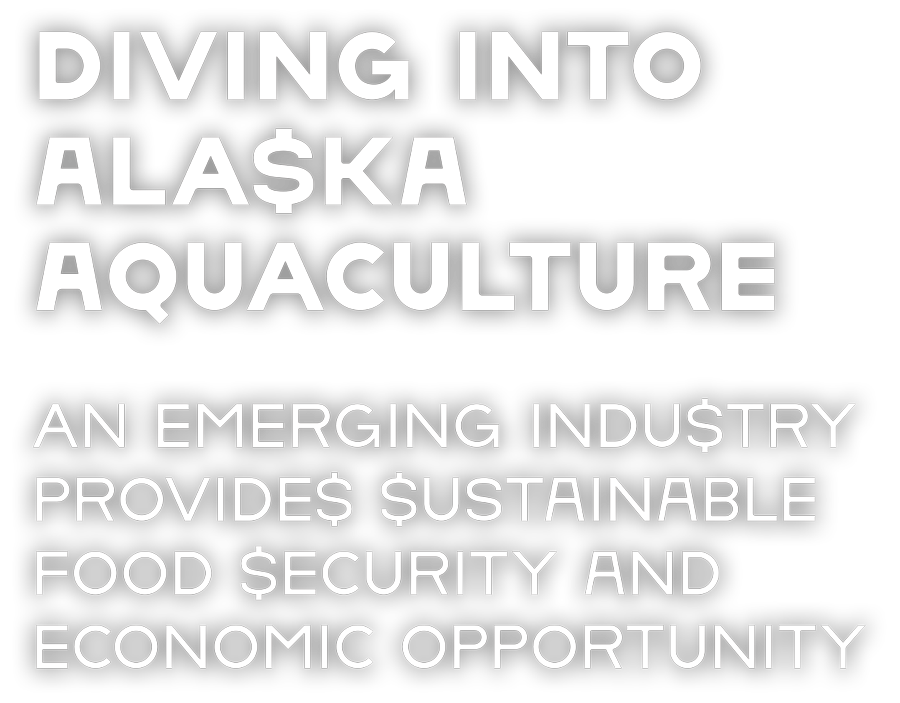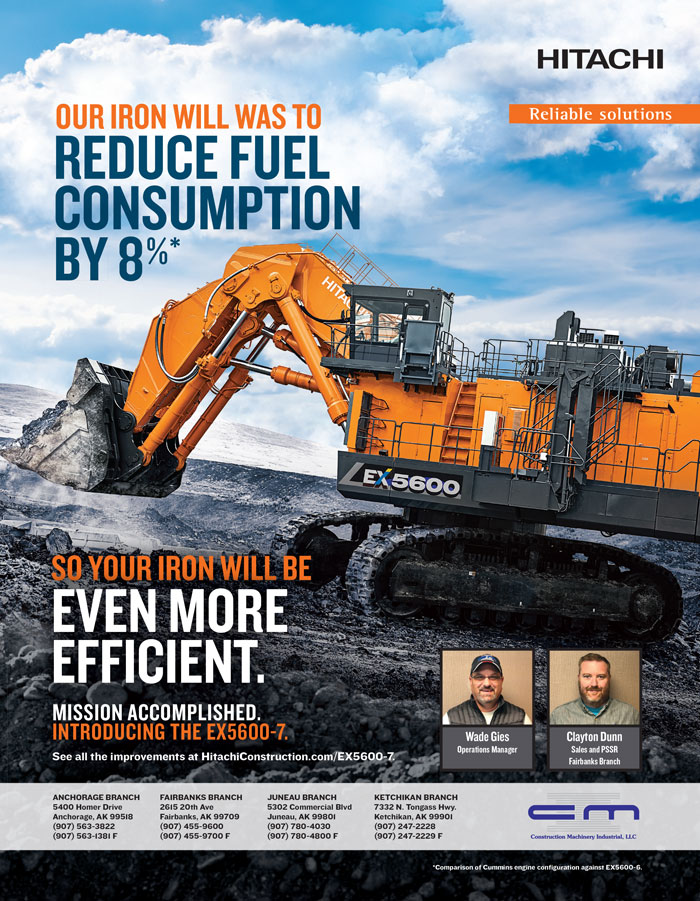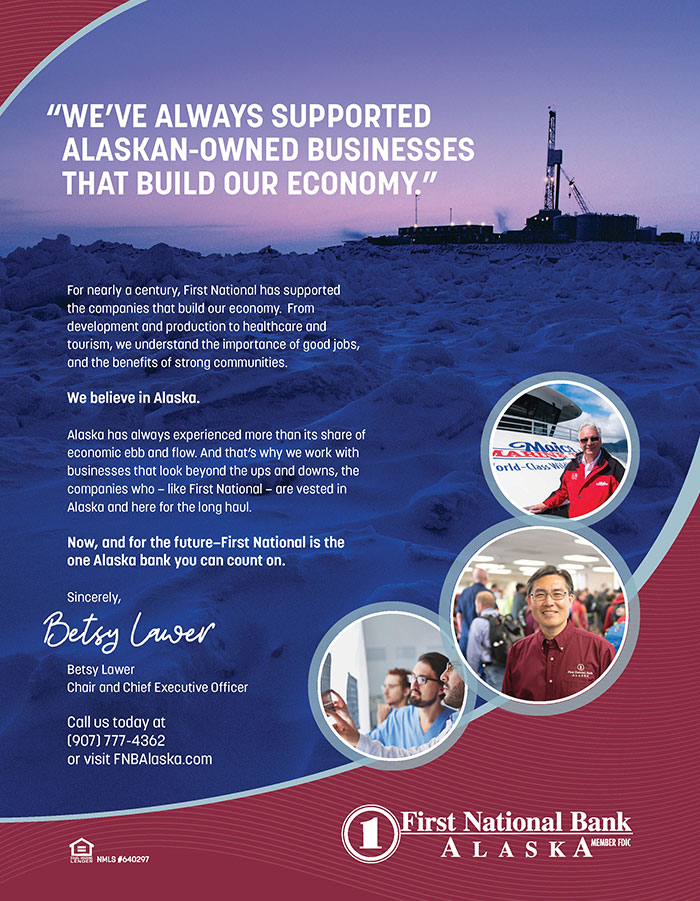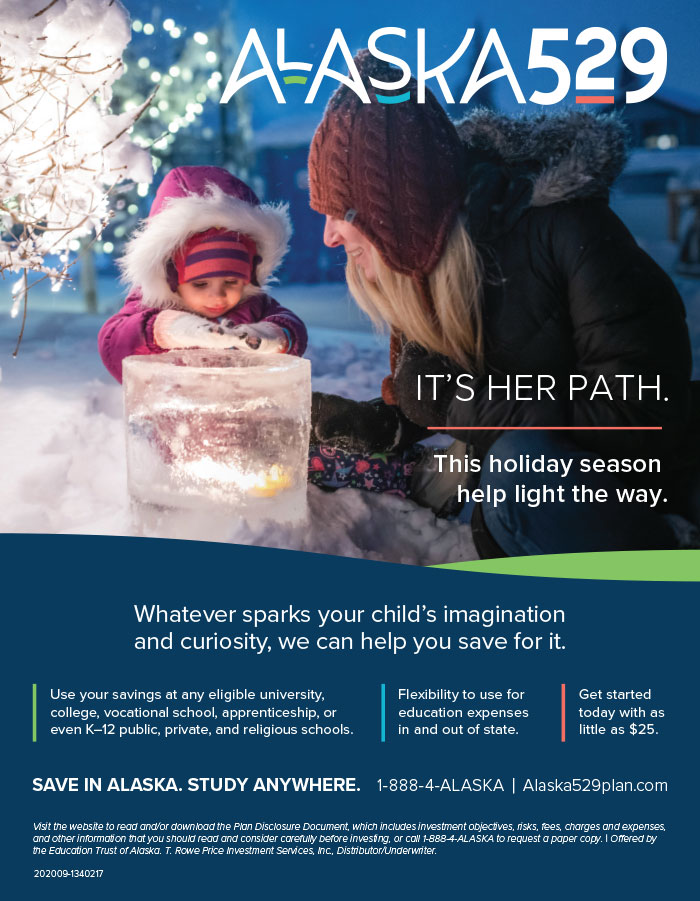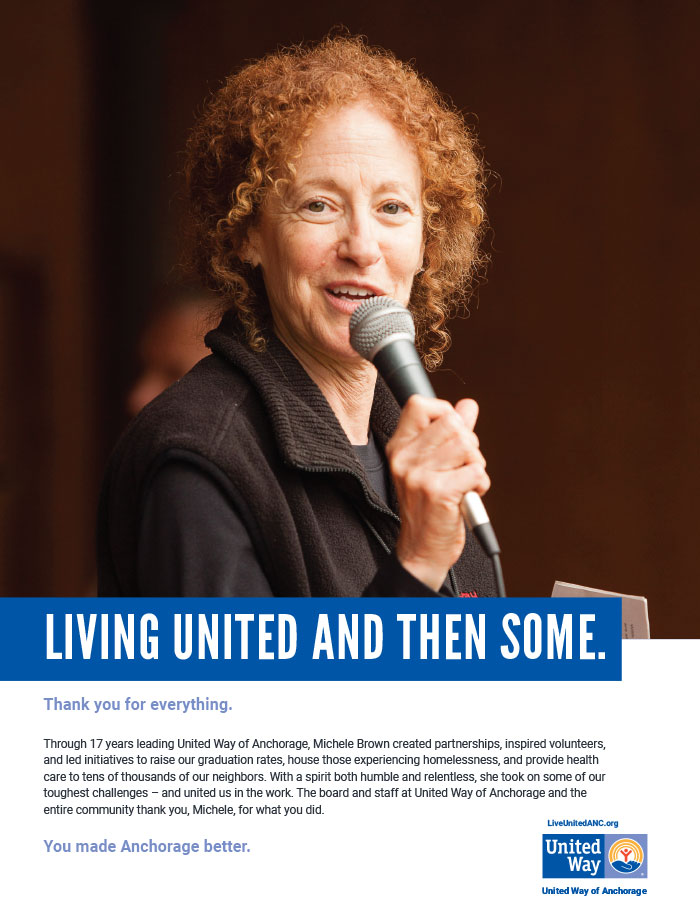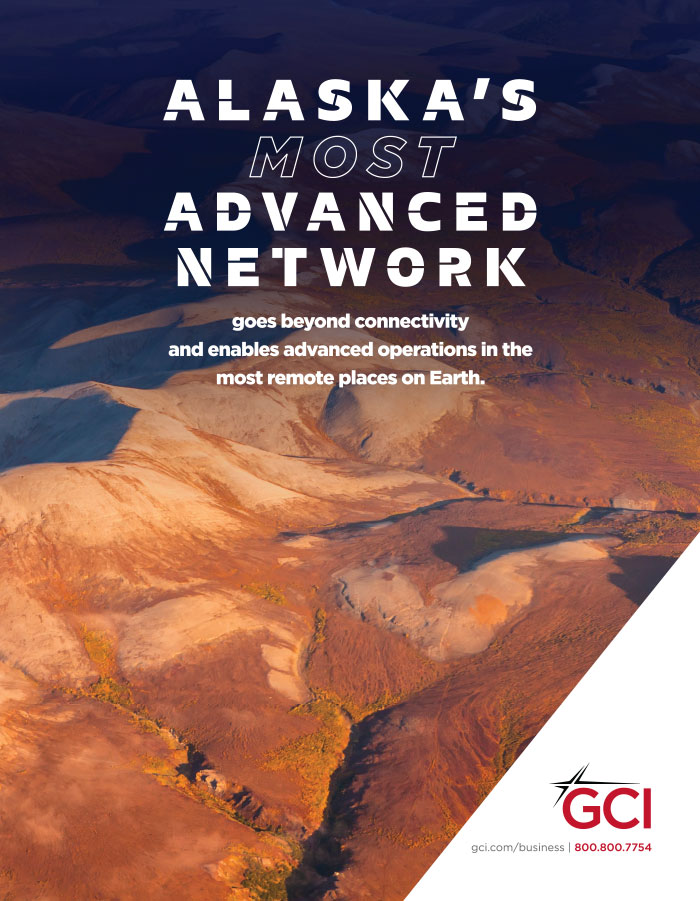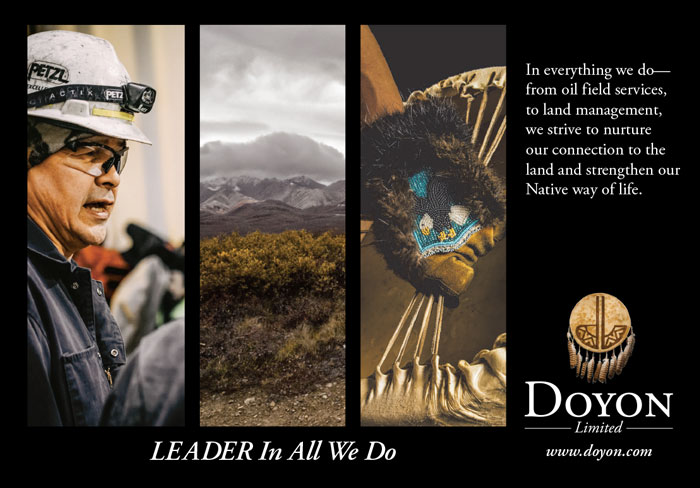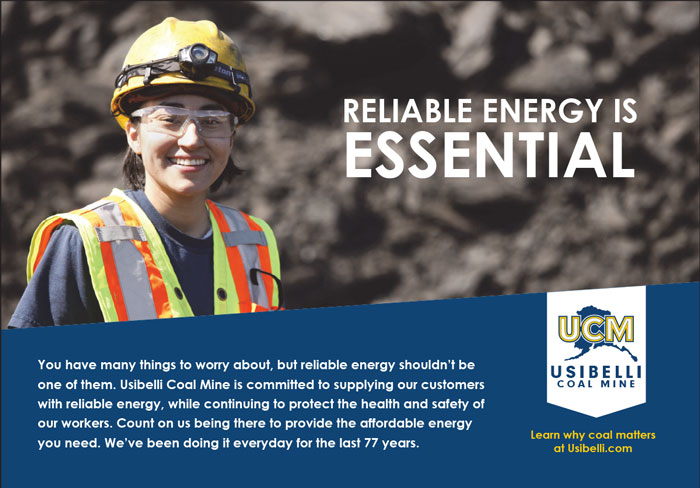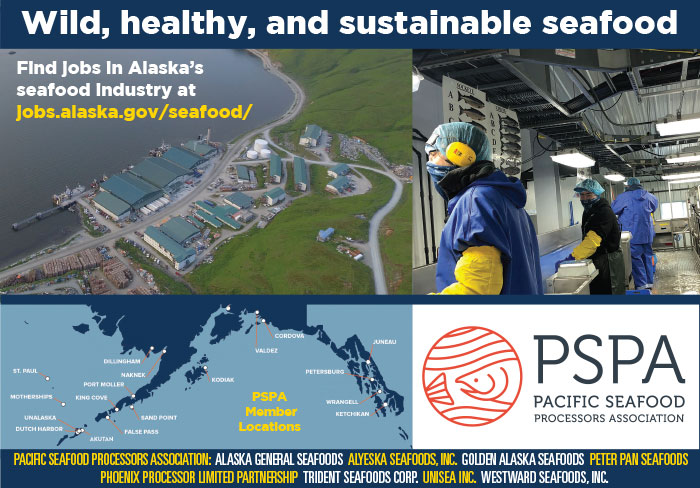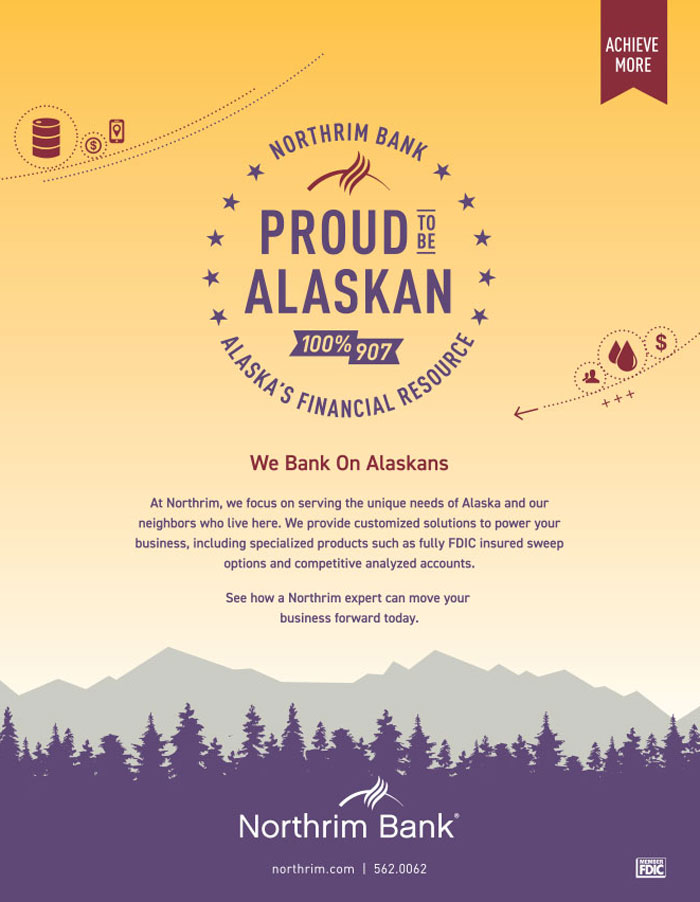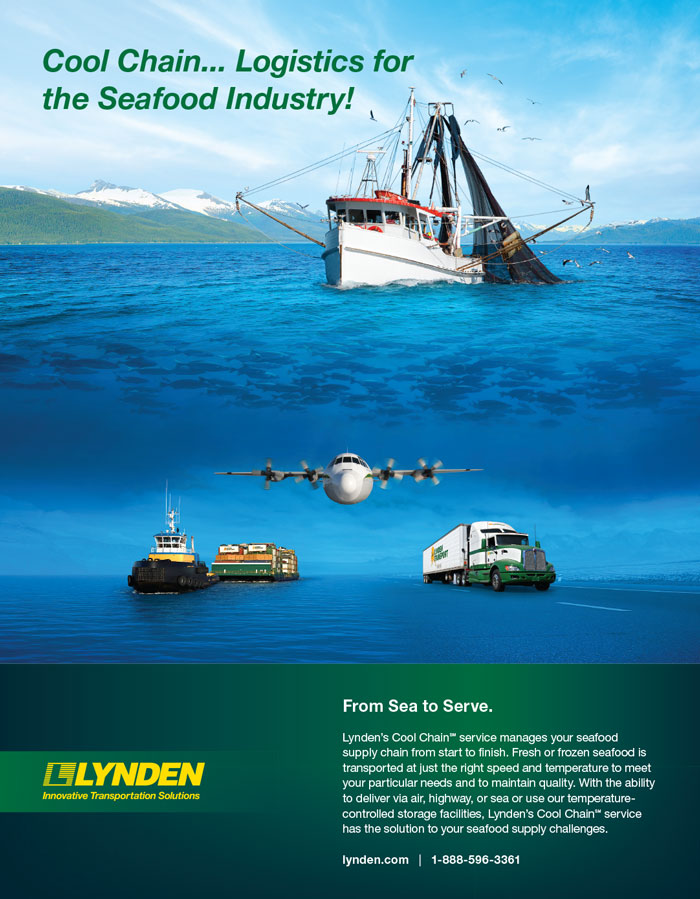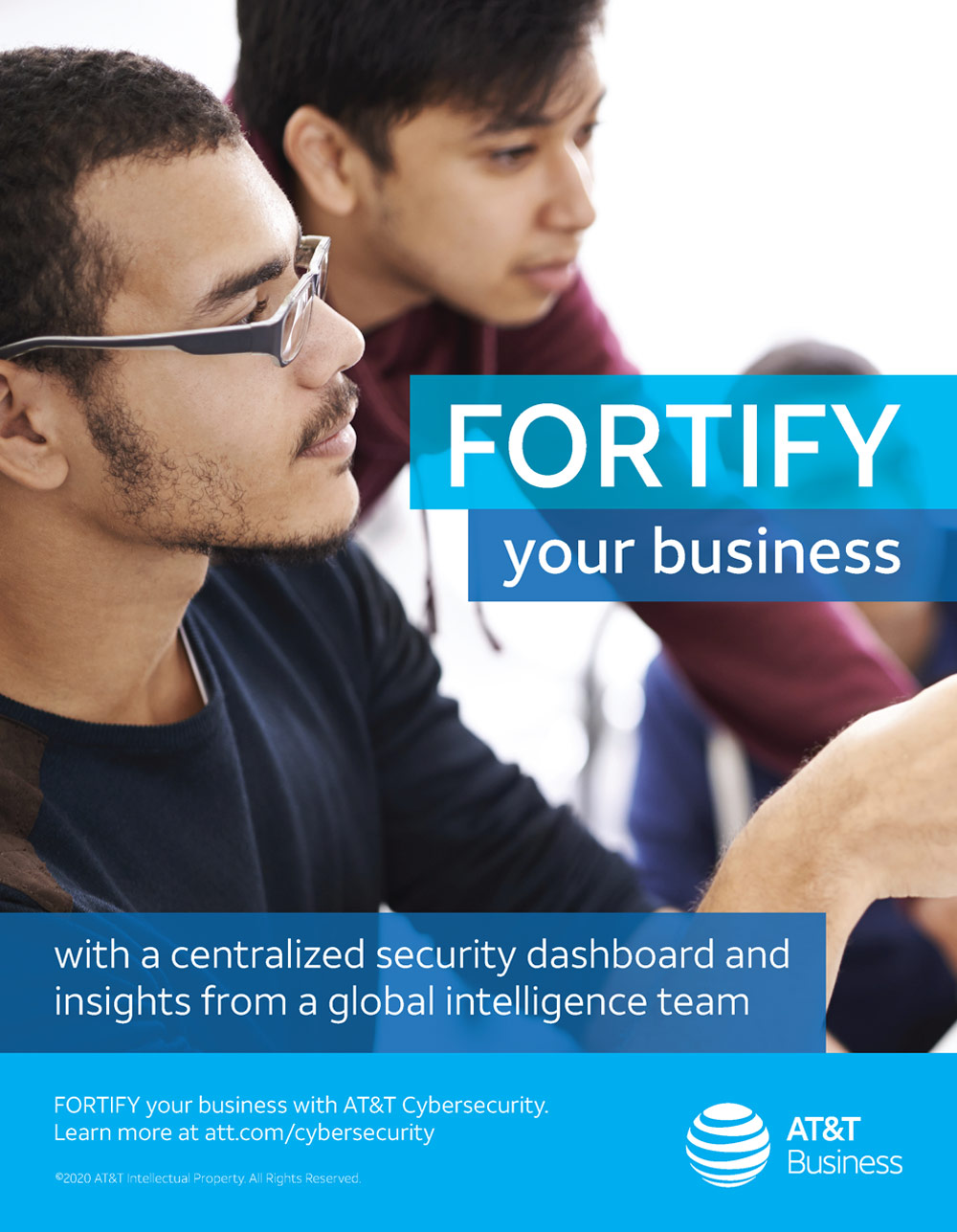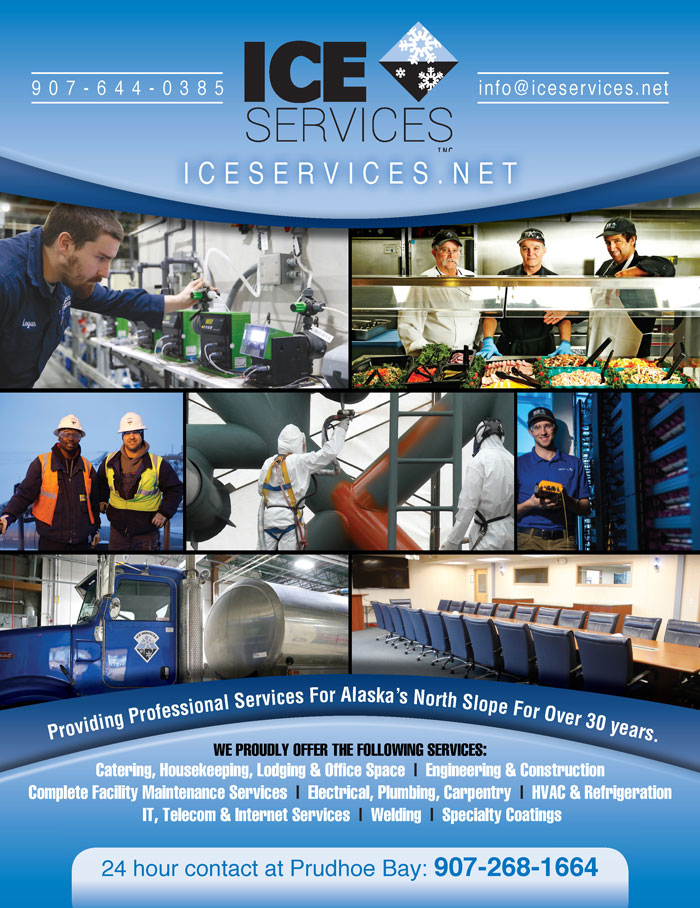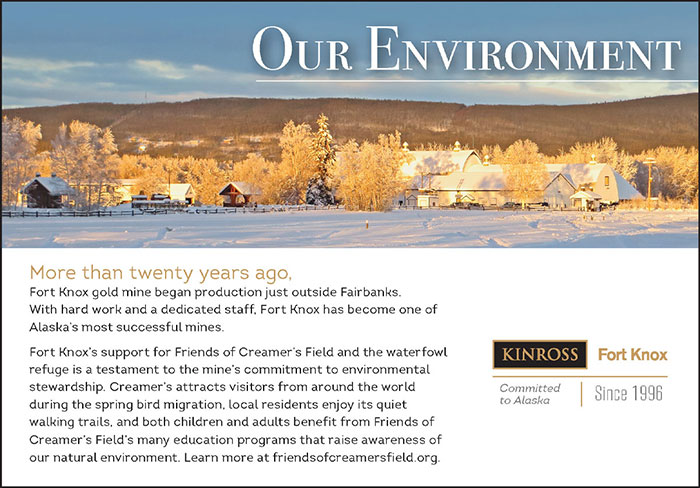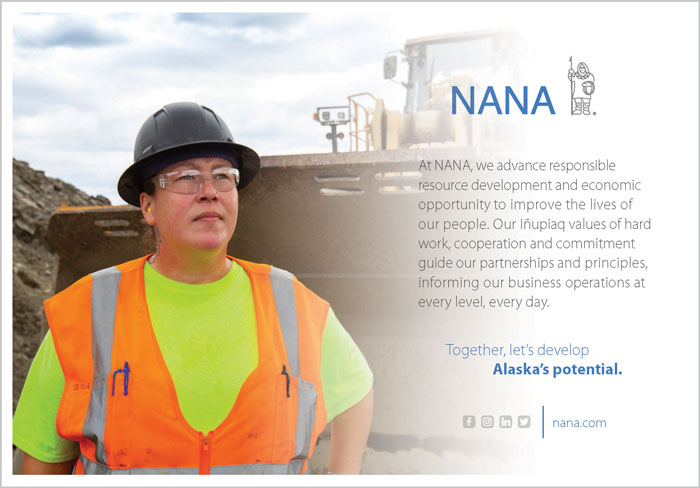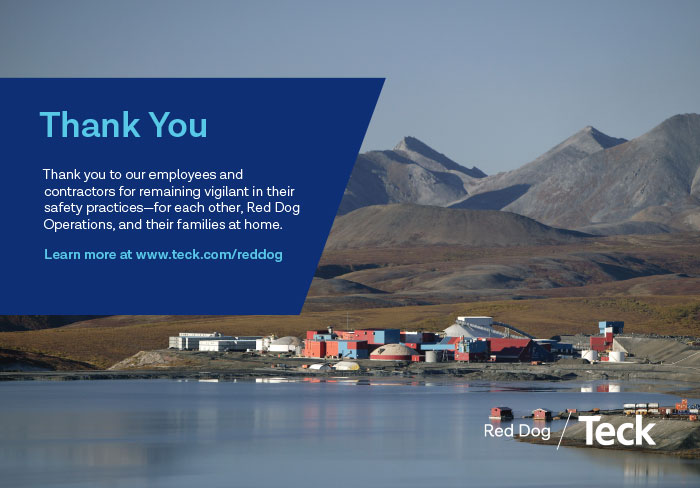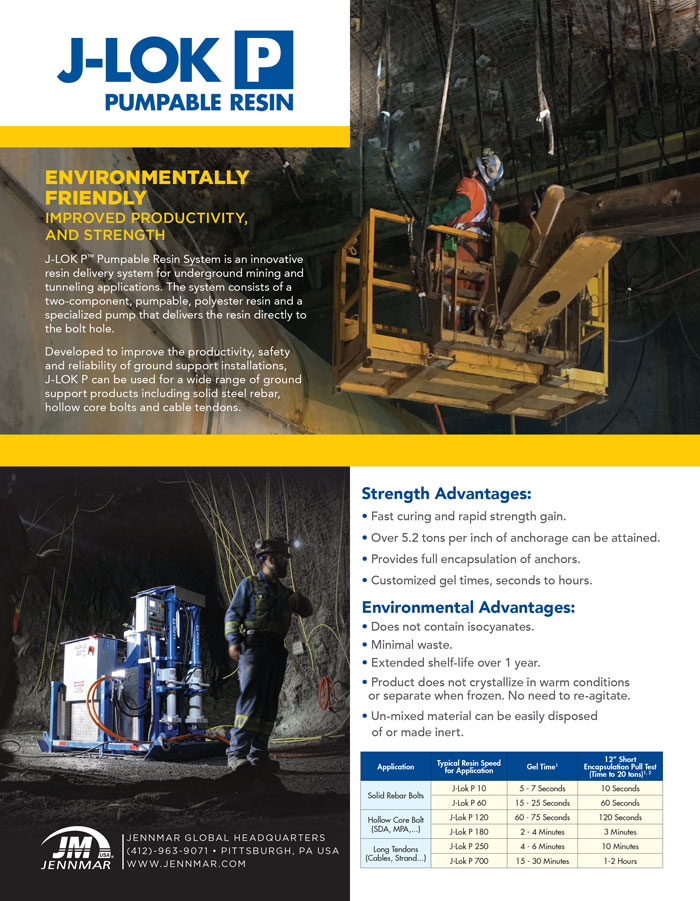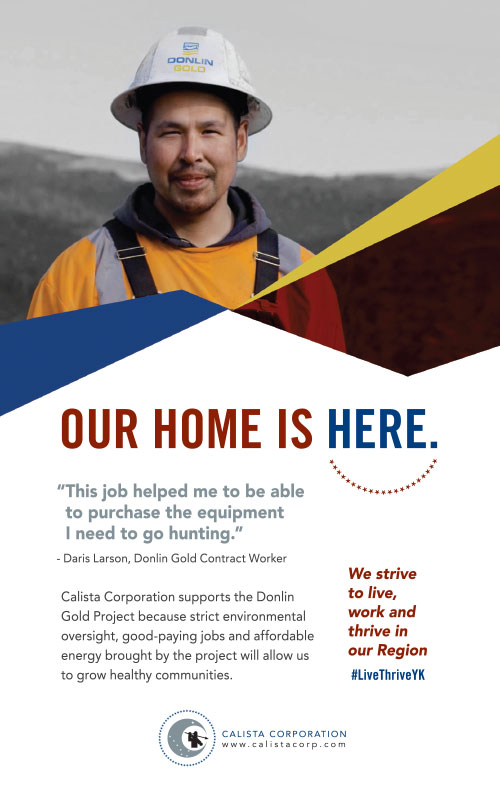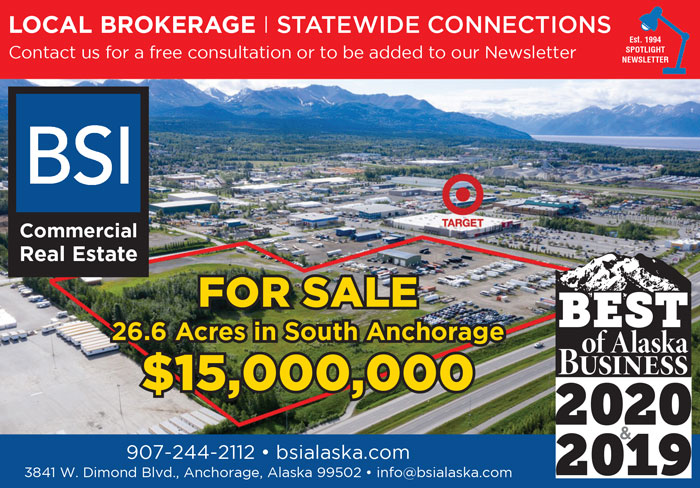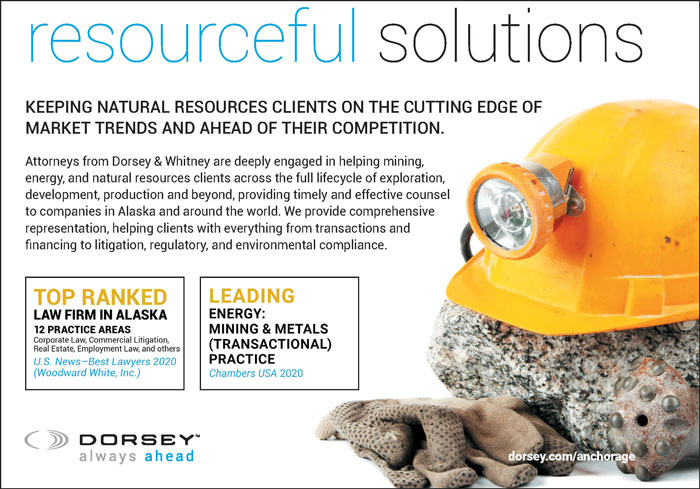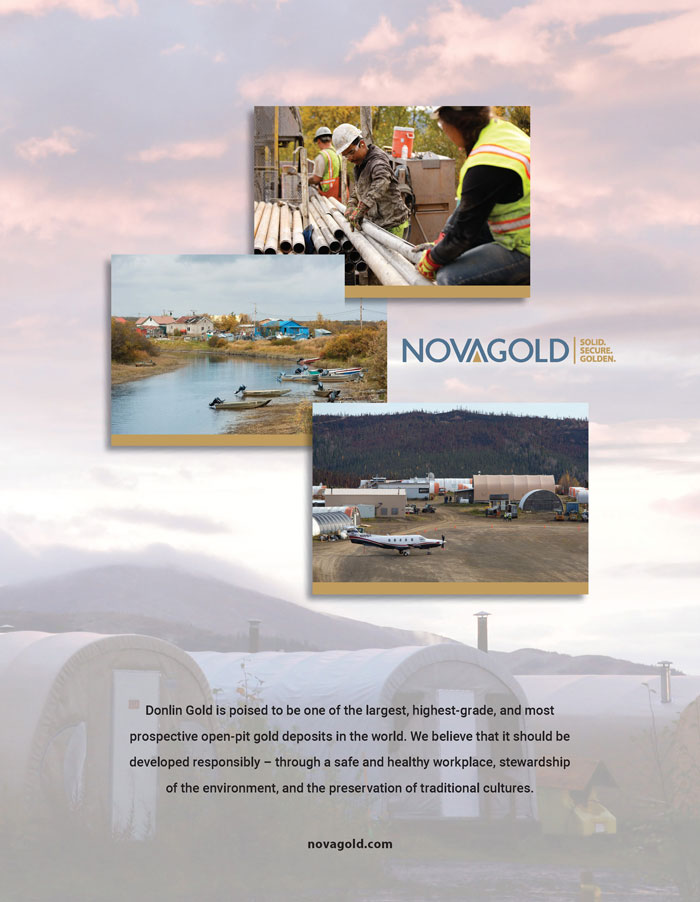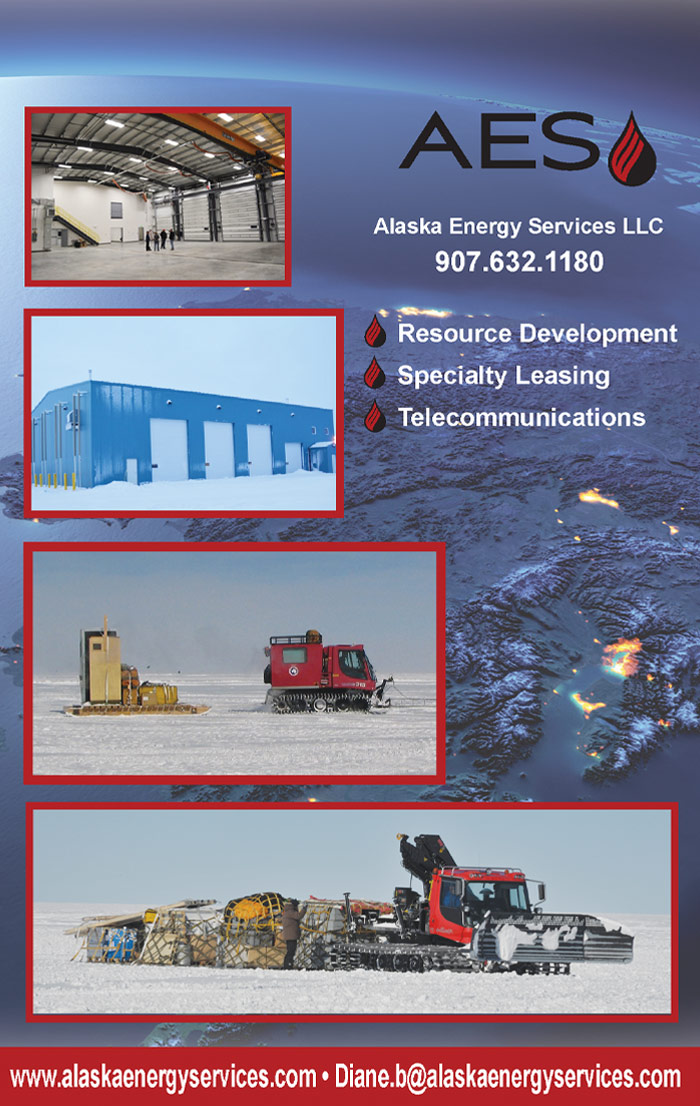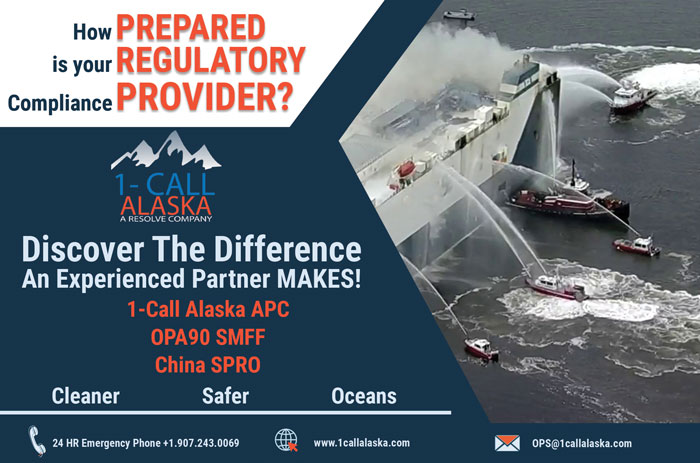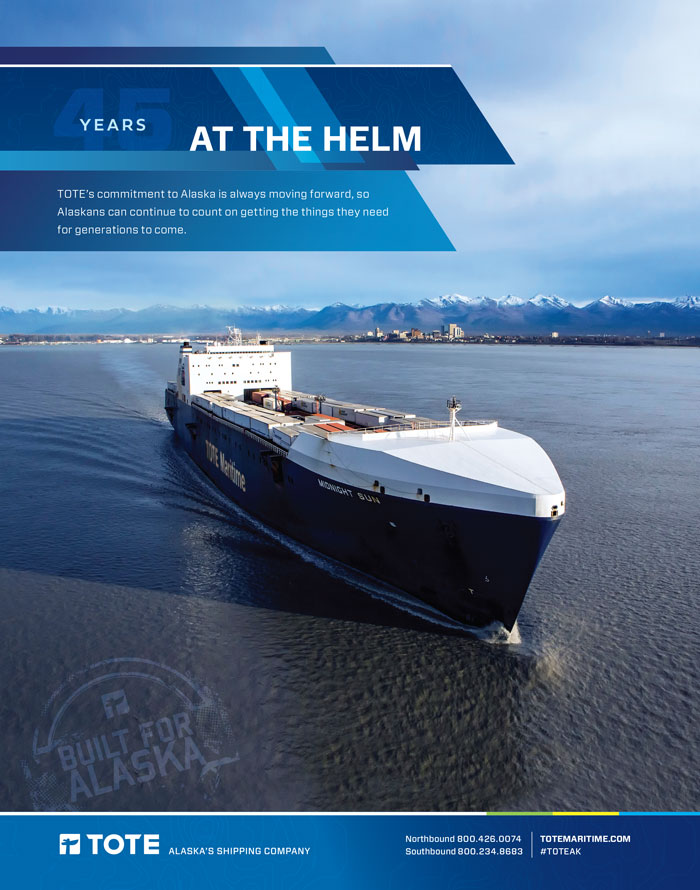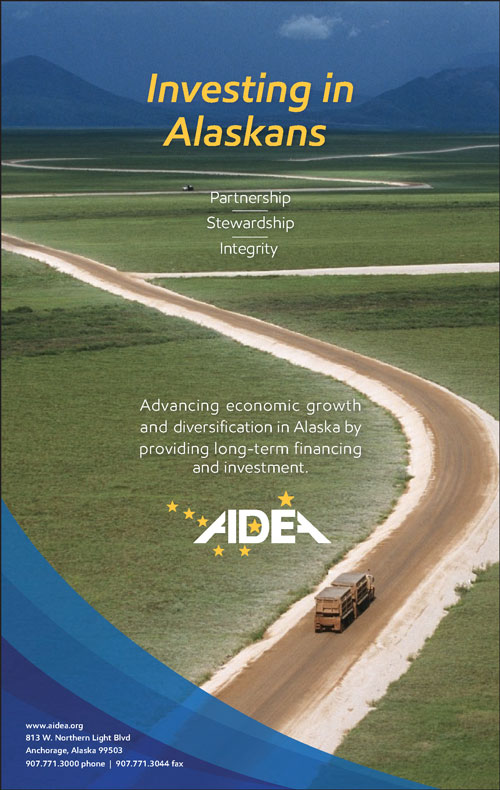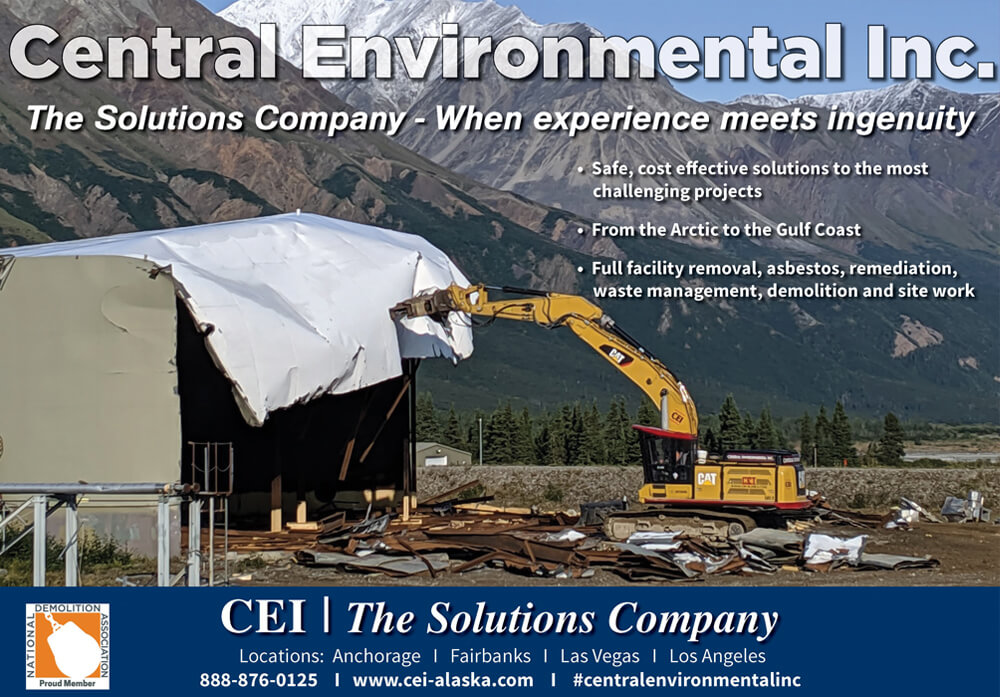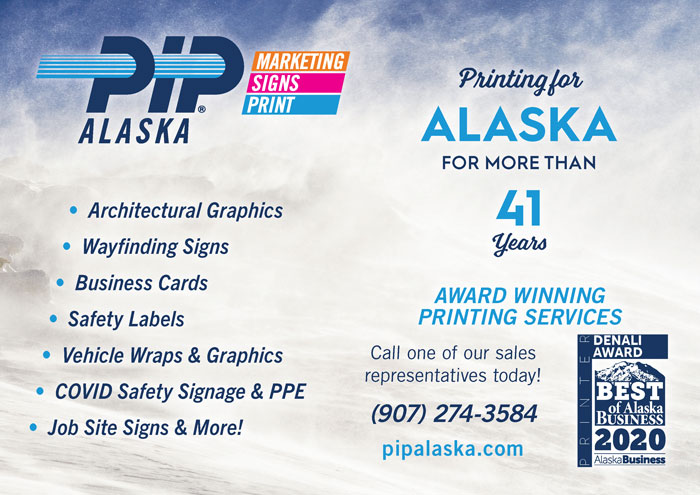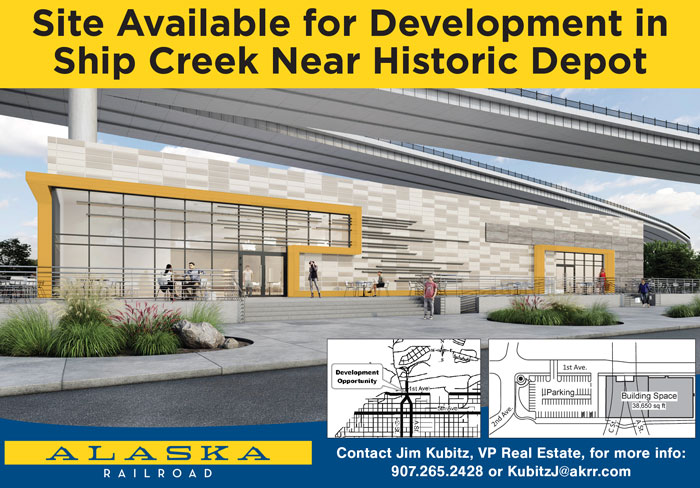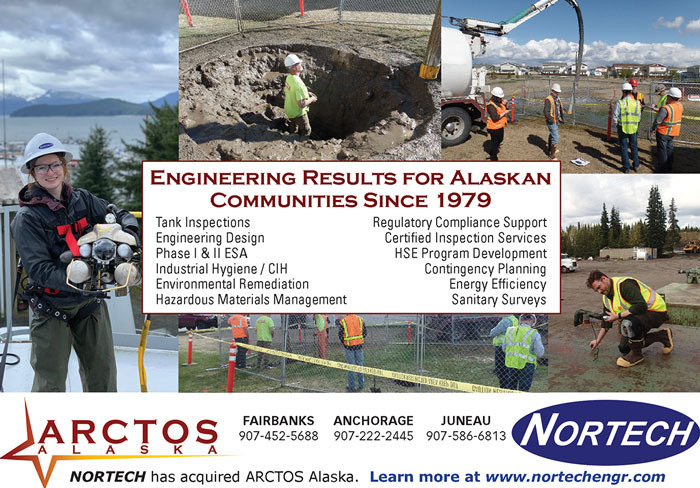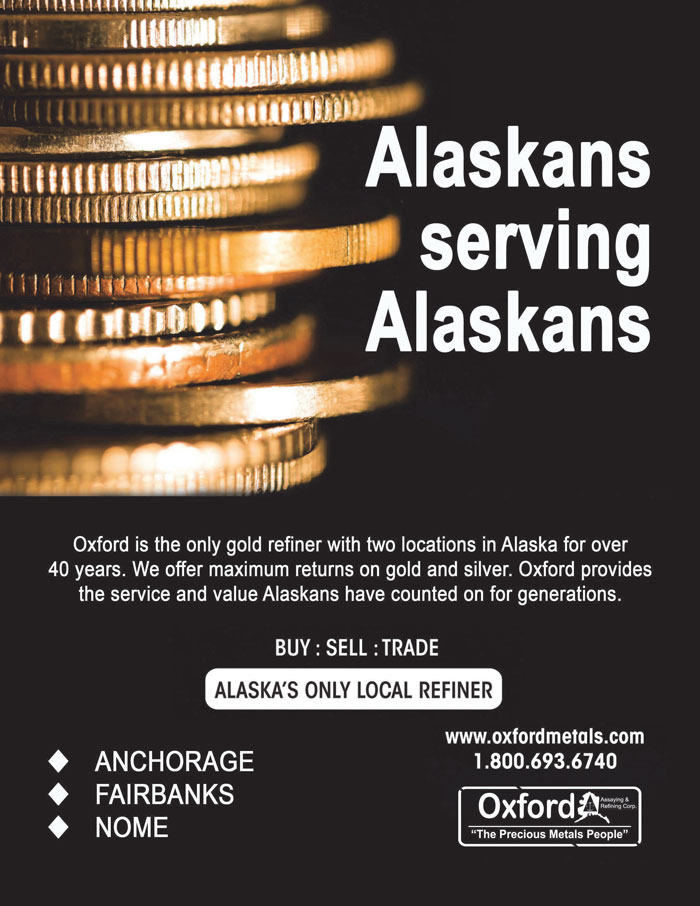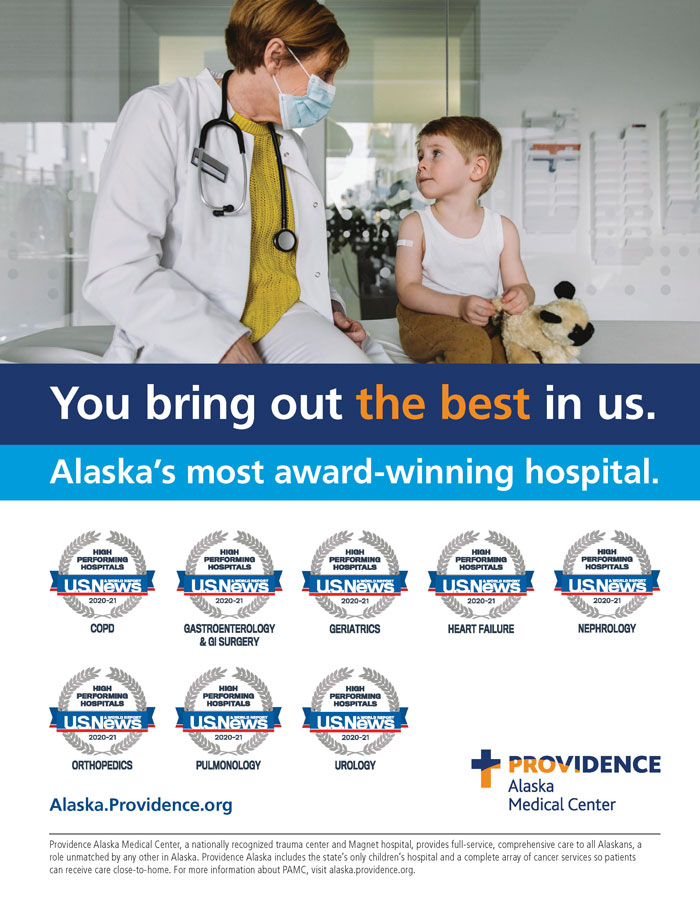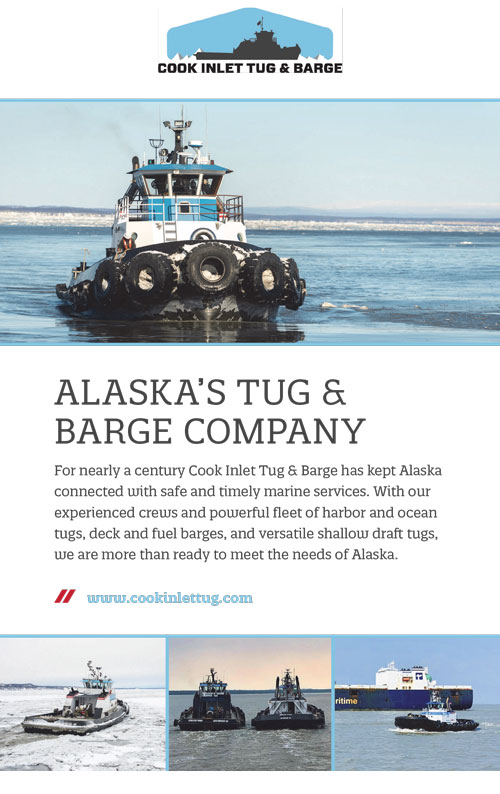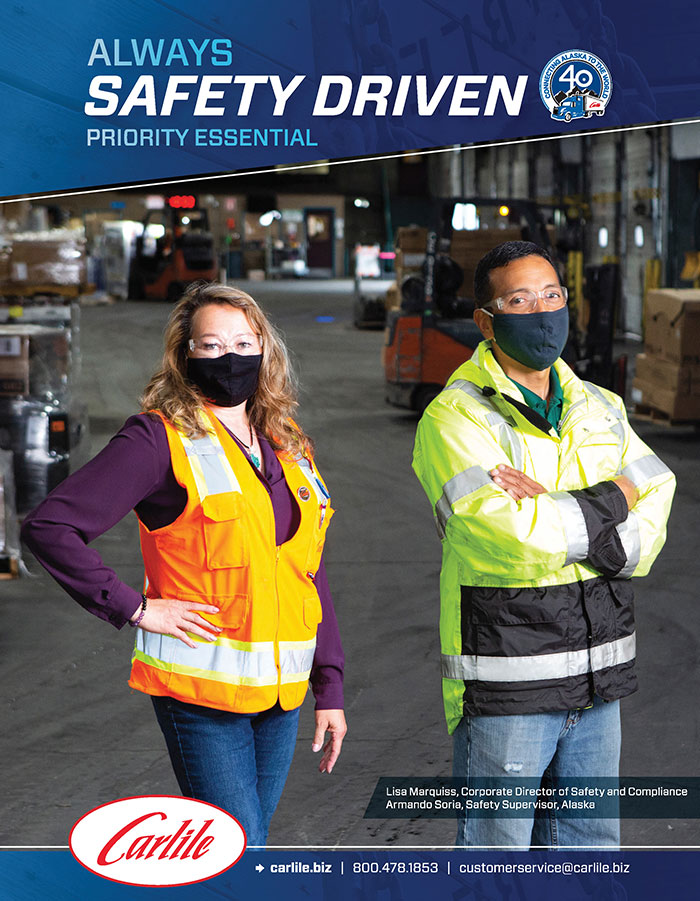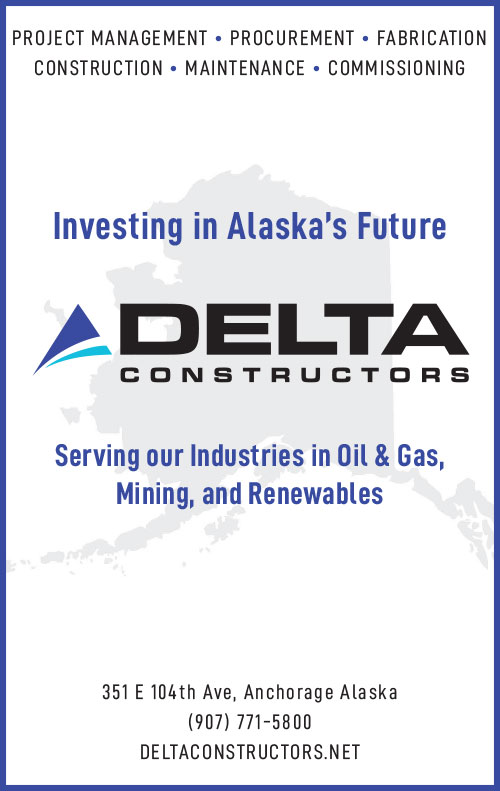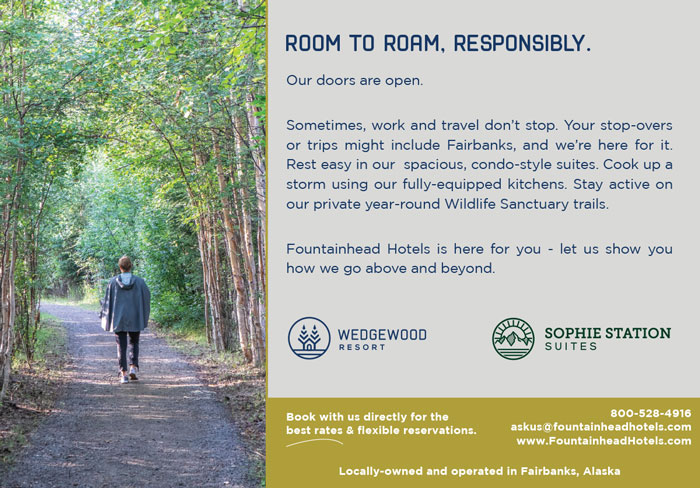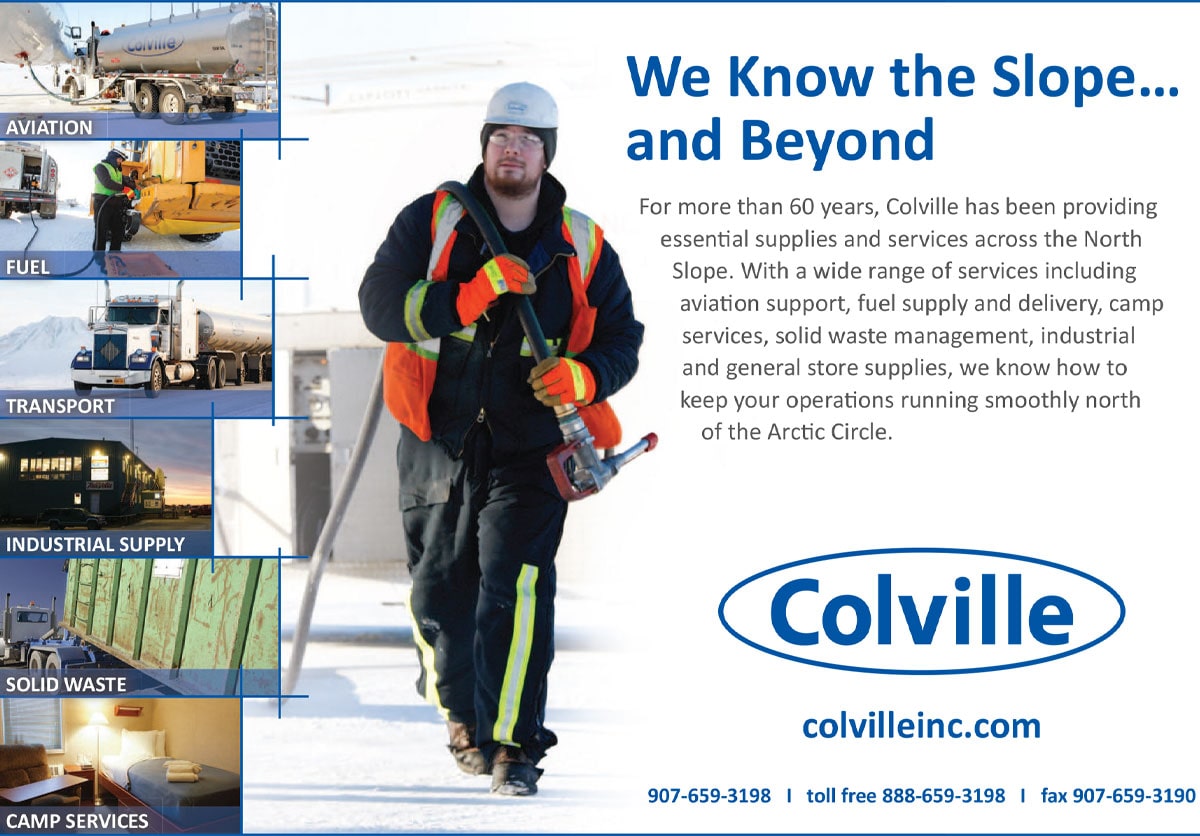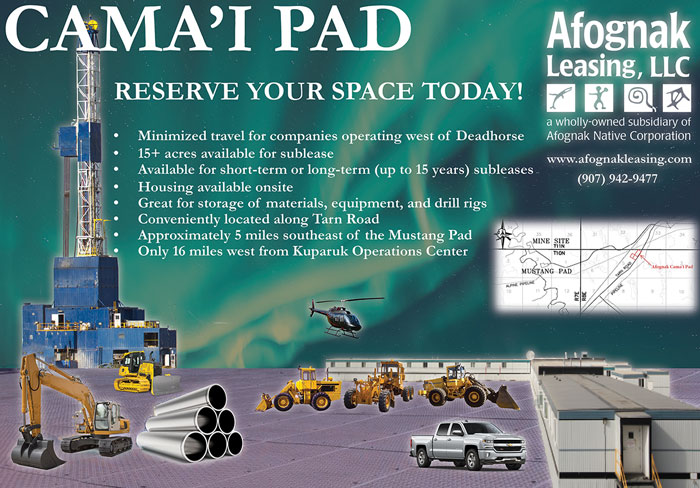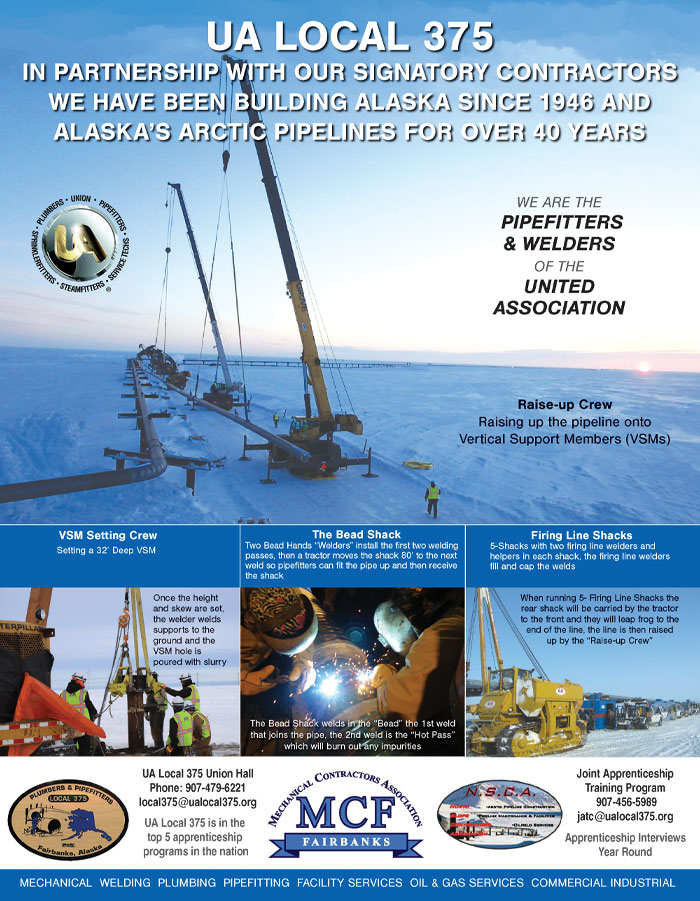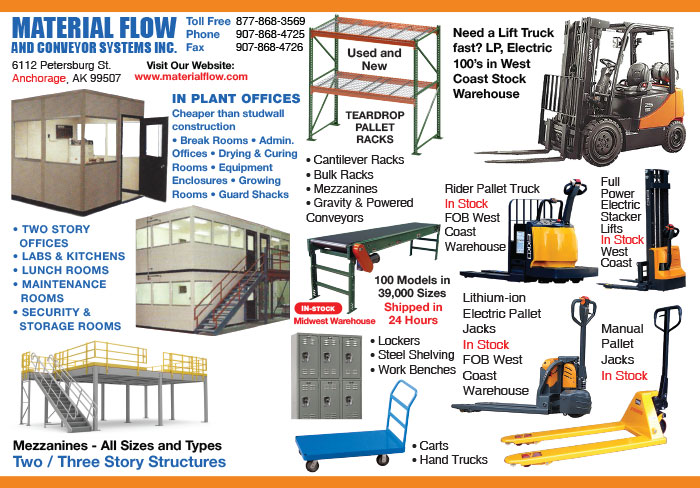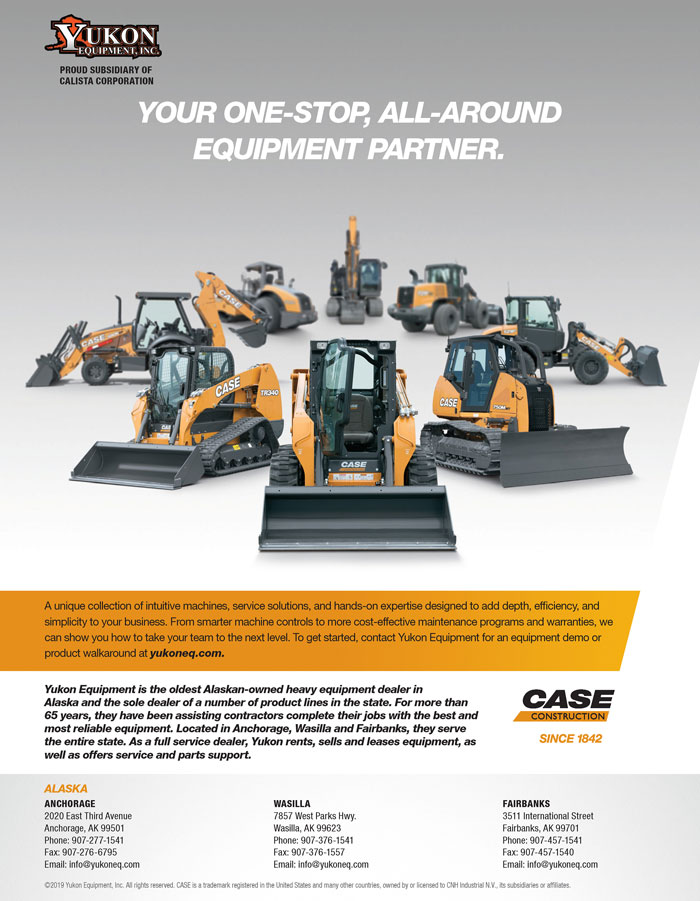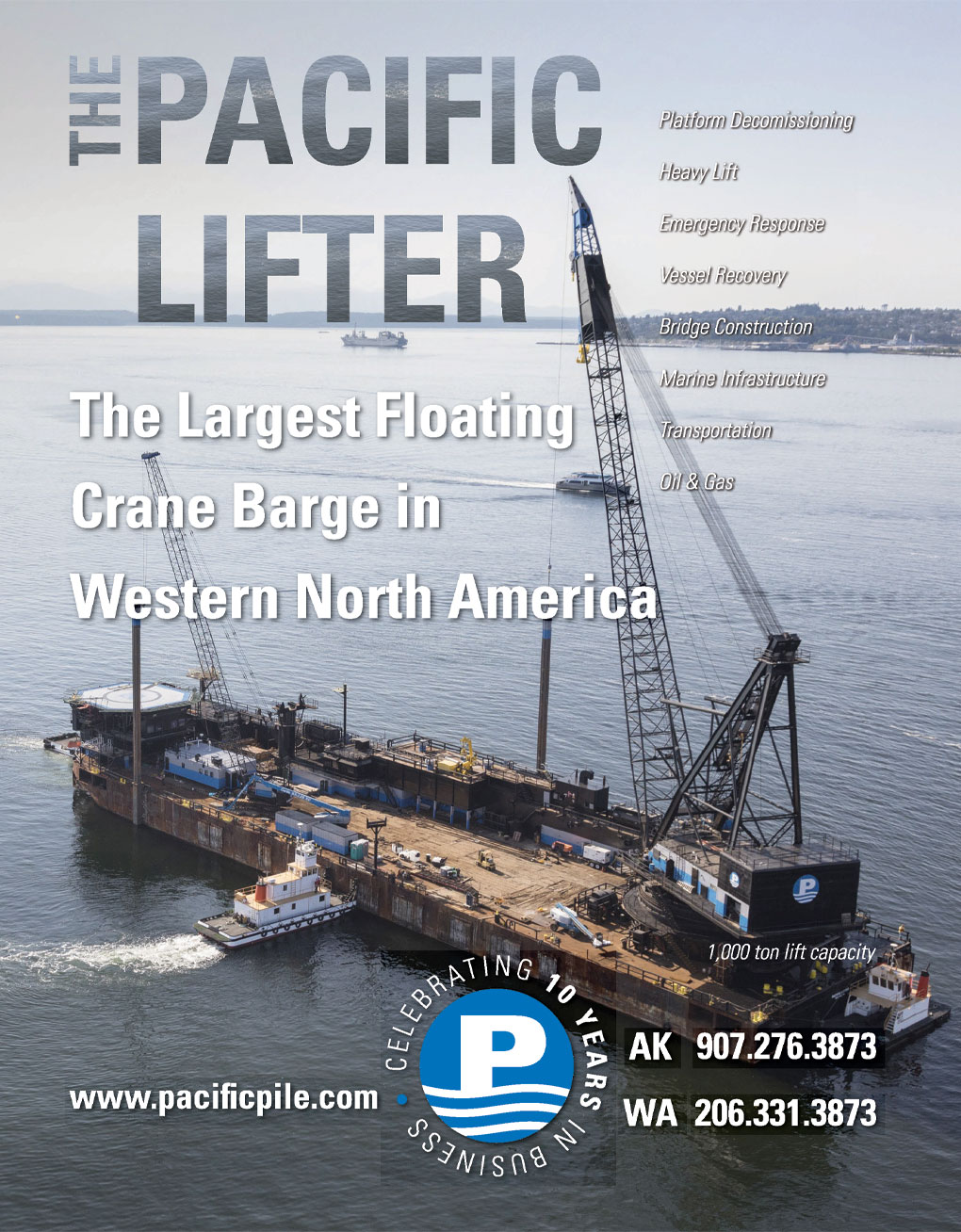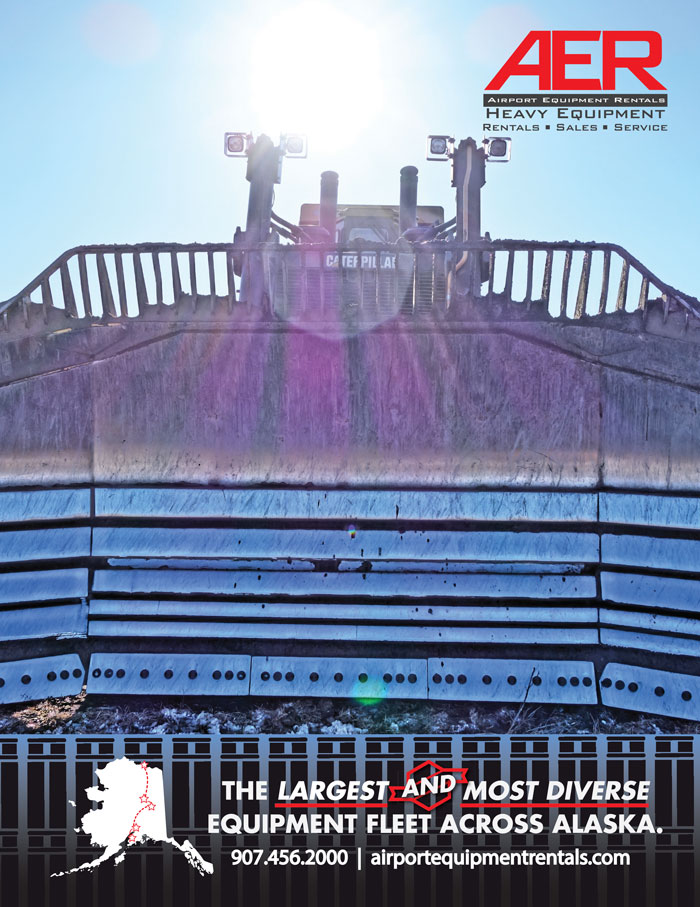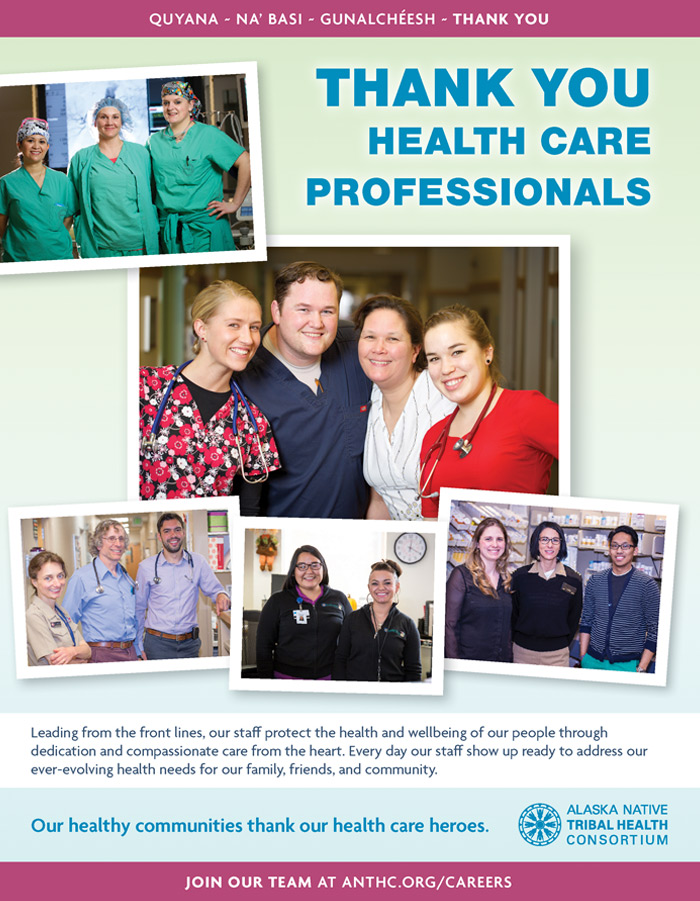Contents
Features
Building Trust Through Transparency
By Tracy Barbour
By Danny Kreilkamp
By Vanessa Orr
By Isaac Stone Simonelli
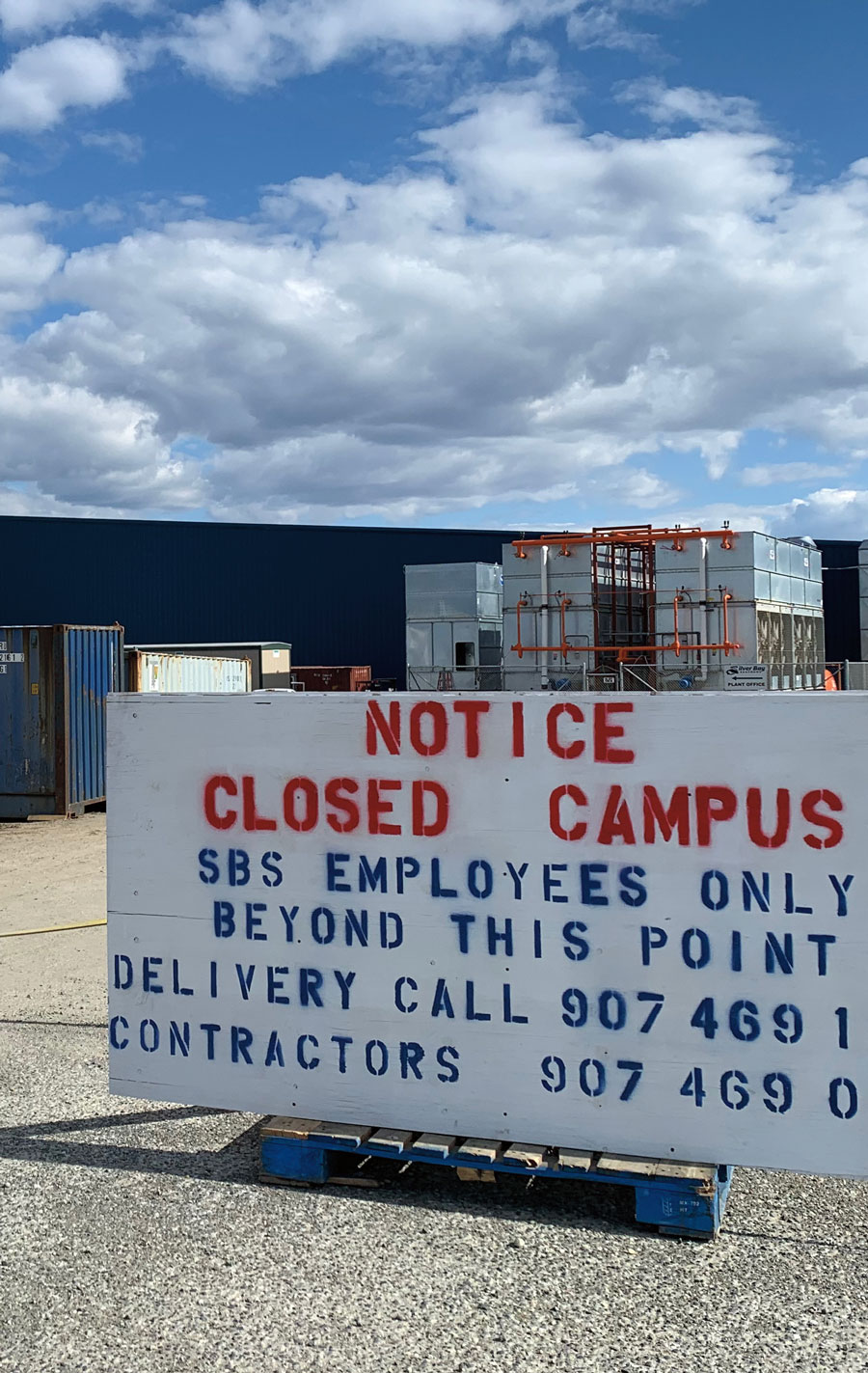
By Isaac Stone Simonelli
By Isaac Stone Simonelli
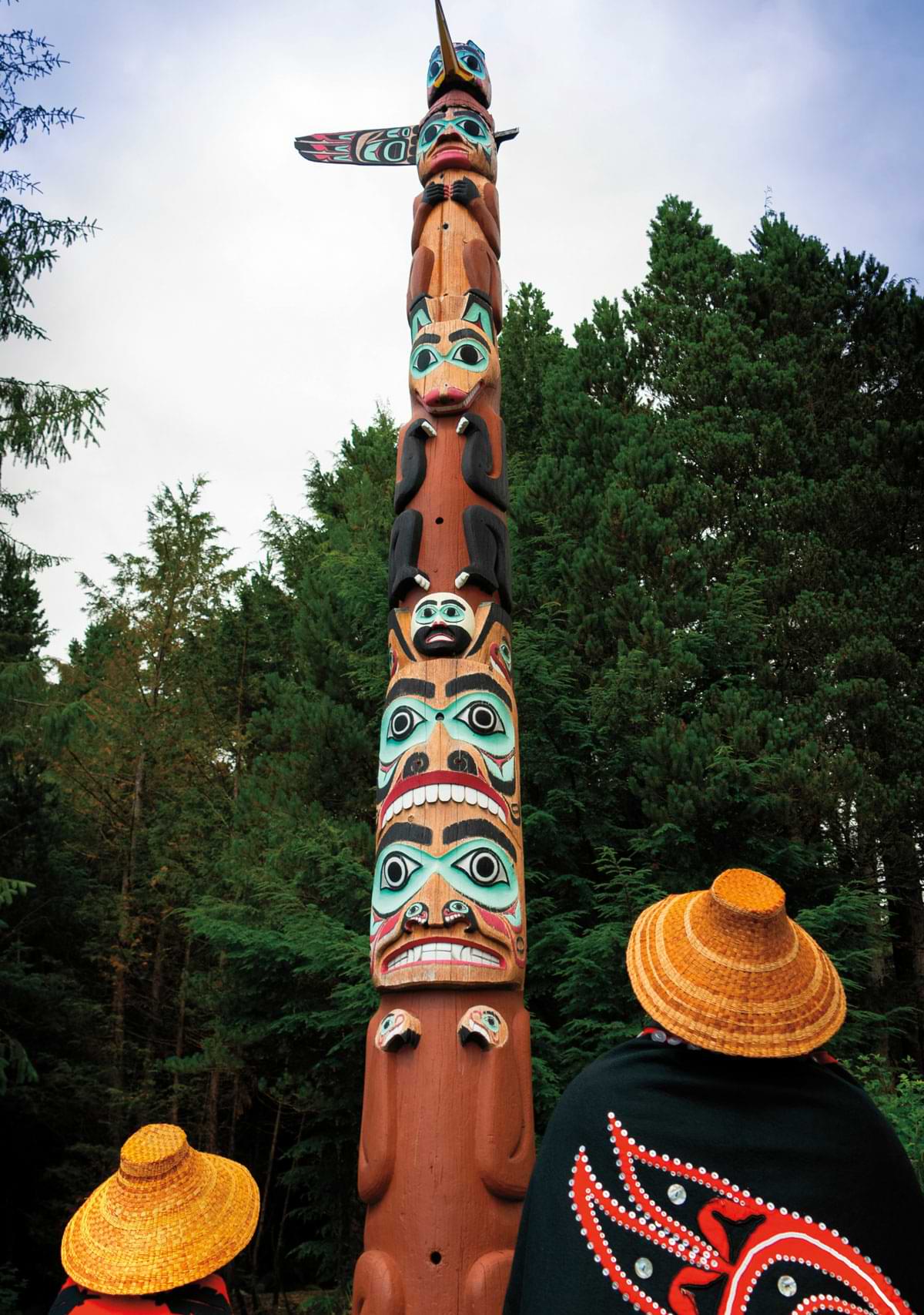
Building Trust Through Transparency
By Tracy Barbour
By Danny Kreilkamp
By Vanessa Orr
By Isaac Stone Simonelli

Quick Reads
By Kathryn Mackenzie
By Sam Friedman
By Kathryn Mackenzie
By Vanessa Orr
By Tasha Anderson
By Julie Stricker
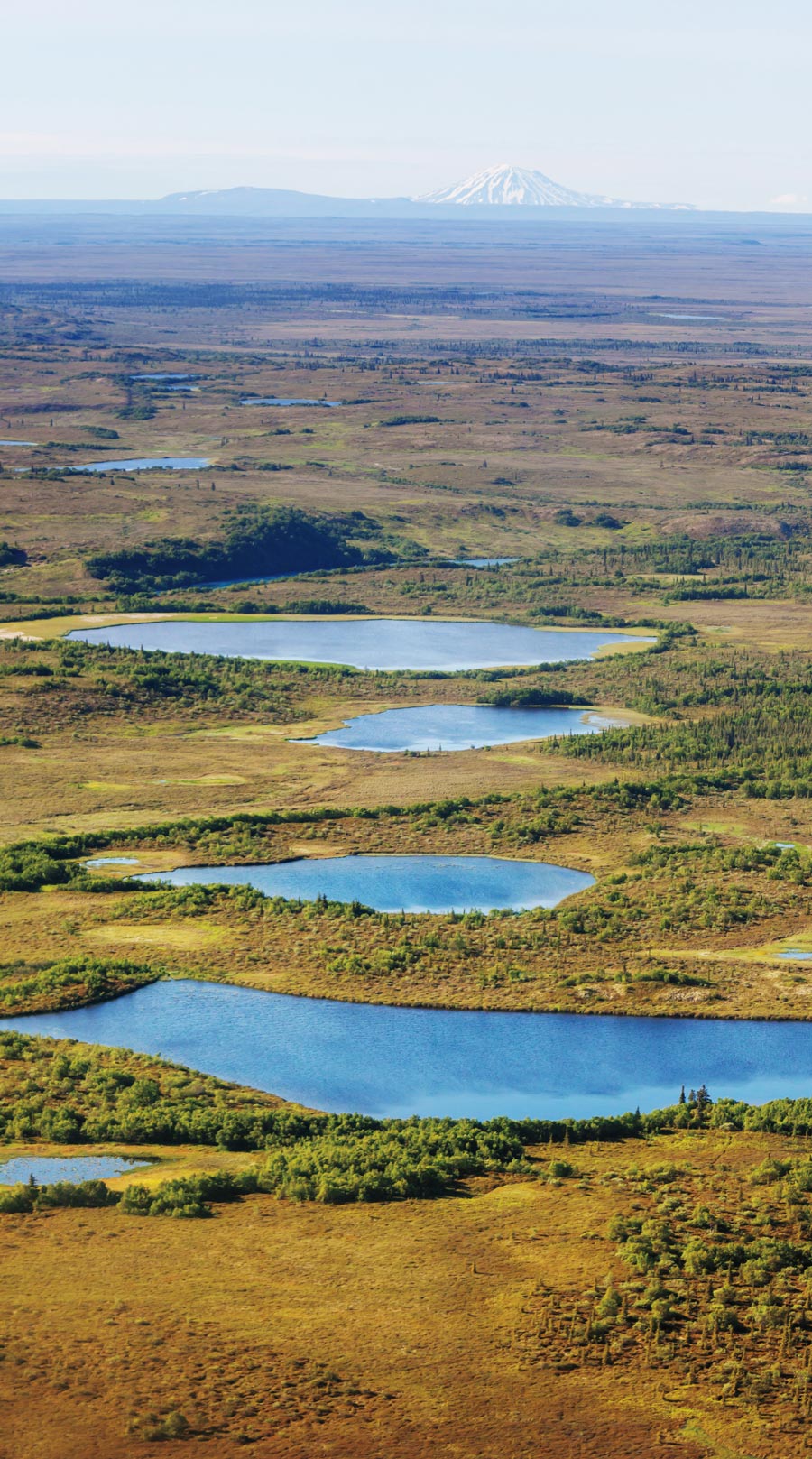
By Amy Newman
About The Cover
Natural resource development and matters of sustainability aren’t always the wildly opposing concepts they’re often made out to be. The industry highlighted on this month’s cover of Alaska Business is a testament to this notion. Marine aquaculture, or farmed seafood, is the harvesting of plants and animals in aquatic environments—and it’s finally beginning to bloom.
According to a leading institute for applied research, Nofima, farming fish uses less greenhouse gas emissions than land-based farming practices. But it doesn’t stop there; aquaculture also means year-round jobs, food security, improved coastal resilience, and a vibrant cover for our November issue.
Photography from National Geographic Image Collection
By Amy Newman
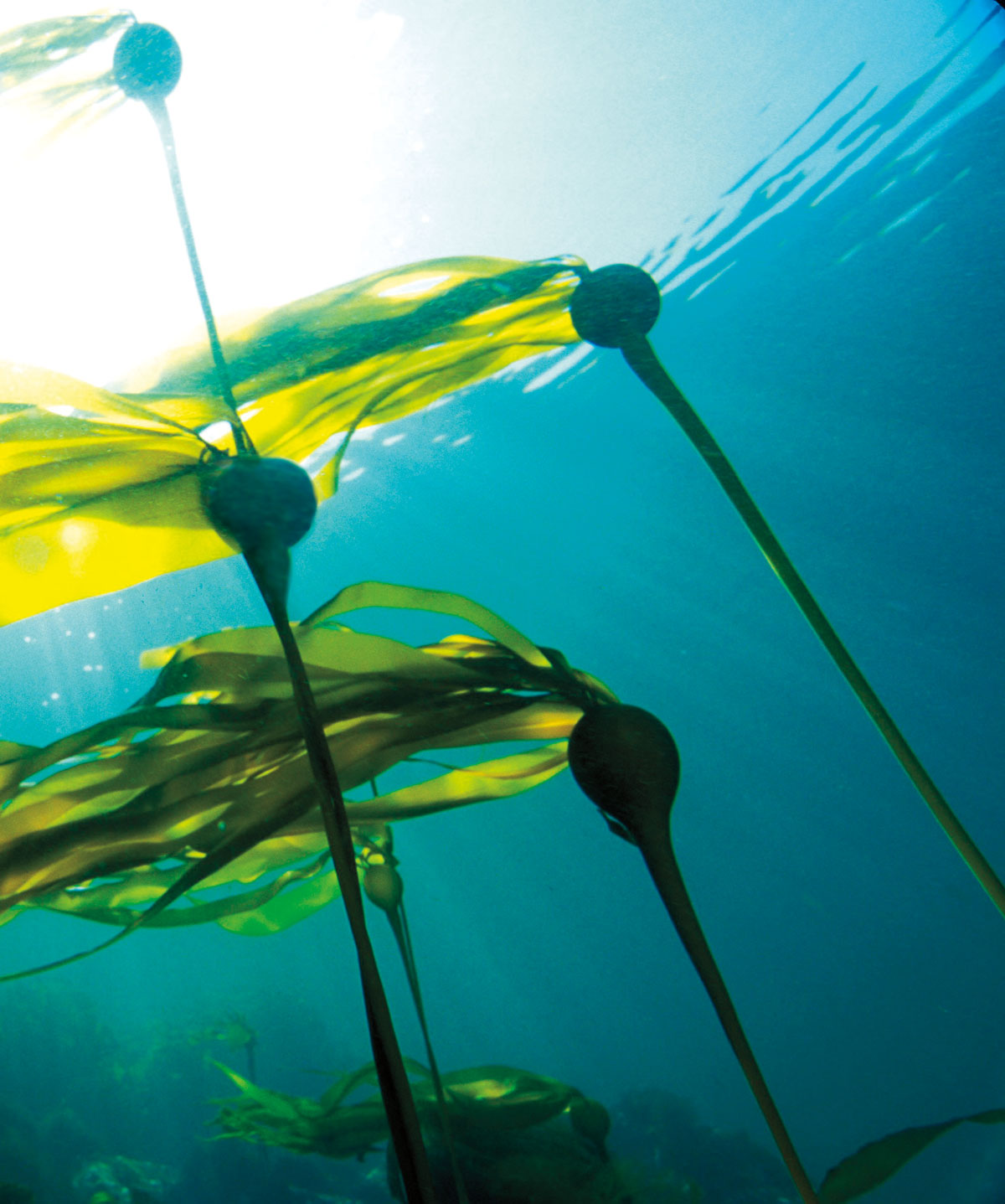
By Kathryn Mackenzie
By Sam Friedman
By Kathryn Mackenzie
By Vanessa Orr
By Tasha Anderson
By Julie Stricker

About The Cover
Natural resource development and matters of sustainability aren’t always the wildly opposing concepts they’re often made out to be. The industry highlighted on this month’s cover of Alaska Business is a testament to this notion. Marine aquaculture, or farmed seafood, is the harvesting of plants and animals in aquatic environments—and it’s finally beginning to bloom.
According to a leading institute for applied research, Nofima, farming fish uses less greenhouse gas emissions than land-based farming practices. But it doesn’t stop there; aquaculture also means year-round jobs, food security, improved coastal resilience, and a vibrant cover for our November issue.
Photography from National Geographic Image Collection
From the Editor
t’s officially my favorite time of year. I know that far more people get excited about the Midnight Sun than the (what’s the opposite of a midnight sun?) long, cold days of winter. But come on, what’s not to love about the Northern Lights against a velvet-black night sky? Or a fresh blanket of untouched snow glistening in the noon sunrise? Year after year I find myself bedazzled by winter here and continue to be grateful that I get to experience all that Alaska has to offer by just stepping outside.
And over the past several months I’ve found myself revisiting again and again the idea of gratitude and resilience. To be resilient, by definition, requires a challenge to overcome—and right now we all face one of the most demanding, impactful challenges of our lifetime. As taxing as 2020 has been—and no doubt, it has been exhausting—I’m also deeply grateful to be here still, helping to support businesses in our communities with news and information about the industries important to you.

Kerry Tasker
Billie Martin
press@akbizmag.com
Postmaster:
Send address changes to
Alaska Business
501 W. Northern Lights Blvd. #100
Anchorage, AK 99503

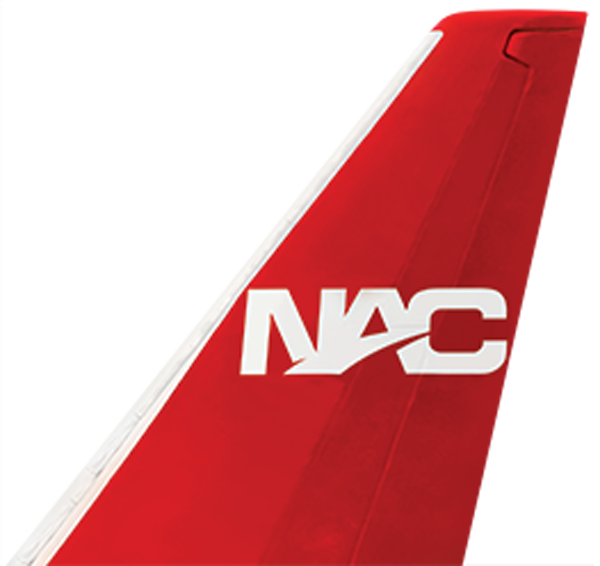

lockchain, an innovative virtual distributed ledger system, is one of today’s most cutting-edge technologies. The technology’s key ingredient is its element of traceability—and it is changing the way the world does business.
Many people are aware of blockchain as the technology that enables the existence of cryptocurrency, a form of digital asset which is secured by encryption, rendering it immune to counterfeiting. But blockchain can be applied to numerous applications including supply chain logistics, seafood, financial, healthcare, insurance, trucking, and oil and gas. So far in Alaska, the seafood industry is delving into the use of blockchain technology in a variety of ways.
Thomas, Head & Greisen PC
o you know how susceptible your business is to fraud? Unfortunately, fraud is alive and well. More than one organization has gone out of business due to fraud. However, there are ways to deter fraud, and ways to detect fraud.
The Association of Certified Fraud Examiners (ACFE) does a survey about every two years. The information provides insight into how and why fraud is committed, as well as ways to prevent and detect fraud. I recommend reviewing the 2020 Report to the Nations (copyright 2020 by the Association of Certified Fraud Examiners, Inc.) https://www.acfe.com/fraud-resources.asp
Everything
Cape Fox Corporation
laska Native Corporations (ANCs) count on diversification among their holdings to provide meaningful dividends and services to their unique shareholders while also growing the corporation to serve future generations.
“Afognak, like other ANCSA village Corporations, is responsible for meeting economic, social, and cultural obligations to its shareholder owners—whose families live in or originate from the village of Port Lions or our ancestral village of Afognak,” says Alisha Drabek, vice president of Afognak Native Corporation.

or seventeen years, Leonardo DRS has consistently delivered costefficient, reliable, and scalable technology solutions throughout Alaska’s remote and challenging environments. The company primarily provides schools and health clinics with broadband services and optimized network applications such as video teleconferencing. It also offers highquality enterprise solutions, including managed services, technology support, cybersecurity, and 24x7x365 network operations.
Leonardo DRS operates and maintains resilient fi ber optic, microwave, and satellite networks, including a 600-mile microwave network from Fairbanks to Allakaket. “We have served over 125 remote Alaska installations, from the Arctic Circle to the Southeast to the Aleutian Chain,” says Vickie Kelly, Business Development Manager, Alaska. “We span the whole state.”
Leonardo DRS is a leading technology innovator and supplier of integrated products, services and support to military forces, intelligence agencies and defense contractors worldwide. The multi-billion-dollar, Arlington, Va.-based contractor facilitates mission-critical, classifi ed programs, providing extremely secure communications, information assurance and network security. “We bring that experience, depth of knowledge, and support into what we do in Alaska,” Kelly says.
hough Alaska seafood industry harvest numbers were not significantly impacted by the COVID-19 pandemic, there was a year-over-year decline in harvest value, according to a McDowell Group report.
The decline in value connected to the pandemic is primarily tied to operating and transportation costs and significant devastation to food service markets.
“In March, when the pandemic started to erupt in the US, the fishing industry realized immediately we were going to need to put safety precautions in place in order to have successful and safe seasons,” United Fishermen of Alaska (UFA) Executive Director Frances Leach says.
he current state of Alaska’s mining sector could be summed up in three words: pandemic, production, and progress. Mining has been deemed an essential business activity here, meaning the state’s operating mines have been allowed to keep operating through the pandemic. Unfortunately that doesn’t mean they’ve been untouched by the novel coronavirus. When cases of COVID-19 began popping up in even the most rural corners of the state, Alaska’s mining companies swiftly implemented new, stricter health guidelines to ensure exploration, development, and production activities could continue while also protecting the industry’s more than 2,600 full-time workers, their families, and communities.


he Pebble Mine project has never been closer to becoming reality. A favorable Environmental Impact Statement (EIS) published in July was a key step in the project’s progression from concept to active mine.
But permitting a large, controversial project is seldom a linear process.
A few weeks after publication of the EIS, several new challenges for the project emerged that could further delay the mine or even completely sink the project’s viability.
t’s been a busy year for Trilogy Metals. The company is focused on exploring and developing its high-grade copper-zinc-lead-gold-silver-cobalt properties in the Ambler Mining District, but that’s not nearly all. Over the course of this year, Trilogy Metals completed the formation of its joint venture—Ambler Metals—with South32 Limited; filed the final EIS for the Ambler access road project; appointed Tony Giardini as its president and CEO; received the go-ahead to begin development of the Ambler access road; and put in place a new management team for Ambler Metals. All this while moving forward with development of the Arctic and Bornite deposits.
So it’s a small miracle that Giardini and Patrick Donnelly, vice president of corporate communications and development, had a spare second to sit down with Alaska Business to talk about mining in Alaska, Trilogy’s joint venture with South32, and the future of the Ambler Mining District.
quaculture is an industry Alaskans are probably familiar with, even if they’re unfamiliar with the term itself.
Broadly, aquaculture refers to the cultivation of numerous species of fish and aquatic plants, such as shellfish, algae, and finfish, as well as enhancement and restoration projects designed to increase wild populations of specific species, says Heather McCarty, vice-chair of the Alaska Mariculture Task Force. Cultivation can be at aquatic farms or, if aimed at restoration and enhancement, hatcheries.
n a state rife with natural resources, it makes sense to try to find ways to use these resources to produce energy. And while Alaska always has been and likely will be heavily reliant on fossil fuels, biomass as an alternative resource is beginning to attract interest.
“Biomass generally refers to plant and animal matter or municipal waste used for energy, though most of the biomass projects in Alaska are thermal wood heat projects,” says Alaska Energy Authority (AEA) Executive Director Curtis Thayer, adding that most of the agency’s biomass work is based around these types of projects.
According to AEA records, community biomass projects date back to 1995, when they applied for funding opportunities through the US Department of Energy. The Alaska Legislature created the Renewable Energy Fund in 2008, which supports biomass projects statewide.
laska is a big place, and its natural resource development projects match that scale: world-class deposits, budgets in the billions, hundreds and thousands of jobs in the making, and associated lawsuits and legal issues introduced by parties nationwide.
In September, fifteen states sued the US Department of the Interior, Interior Secretary David Bernhardt (in his official capacity), and the Bureau of Land Management over the decision to allow drilling in the Arctic National Wildlife Refuge (ANWR), a decision Bernhardt announced in August. According to the suit, the defendants “unlawfully authorized the Coastal Plain Oil and Gas Leasing Program, opening the unspoiled Coastal Plain of the Arctic National Wildlife Refuge to expansive oil and gas exploration and development based on inadequate environmental review and an unlawful Record of Decision.”
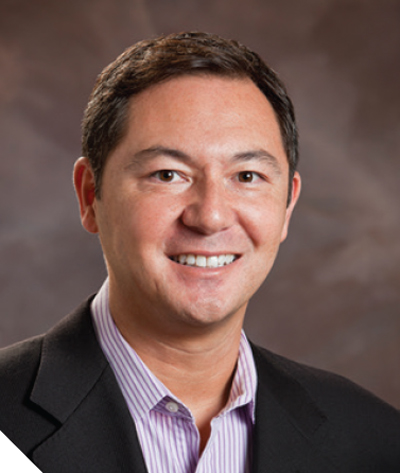
Vice President of Sales
he Alaska Business Spotlight Digital Profile is an excellent way for you to elevate the online presence for your company. These beautifully designed profiles feature content unique from your website that adds SEO value for search engines while promoting your business to visitors to AKBIZMAG.com.
Spotlight Digital Profiles are very affordable and provide 24/7/365 online visibility. We promote these profiles throughout our website, including on the home page, industry news pages, lists, and on the spotlights page itself. Check them out at akbizmag.com/spotlights.
n 1960, nearly 9 million acres in Alaska’s northeast corner was set aside as a protected wildlife refuge—the Arctic National Wildlife Refuge (ANWR).
Twenty years later, then-President Jimmy Carter expanded the refuge to 19.3 million acres, but set aside about 8 percent of ANWR for potential oil and gas development, called the 1002 area after a clause in the Alaska National Interest Lands Conservation Act (ANILCA). The exploration had to be authorized by Congress.
Since that time, ANWR exploration has been repeatedly brought up by Alaska’s congressional delegation but fails to pass. Lawsuits against drilling are filed by a range of organizations, including Earthjustice, National Resources Defense Council, and other environmental groups. Every move on ANWR makes national headlines. Bills from Lower 48 congressmen to return the 1002 area to wilderness status similarly fail.
Then in 2017, President Donald Trump signed the Tax Cuts and Jobs Act, which includes authorization for responsible development. But what looked like a long-fought victory for those seeking to develop the area hasn’t manifested. Nearly three years later, development is dogged by lawsuits.

Samuel Rice, Chief Creative Officer, Zachary Aregood, CEO, Deanna Miller, Director of Client Experience
s an unconventional, full-service marketing agency, ARM Creative excels at providing strategic solutions that generate value and results. The Anchorage firm offers a solid mix of creative development, content creation, and campaign management services to businesses statewide. But the company’s real forte is employing programmatic advertising [digital] to help clients effectively target audiences in real time. “Programmatic takes the guess work out of advertising and provides success metrics that you can use to make strategic business decisions,” says CEO Zach Aregood.
ARM Creative specializes in crafting content in house rather than outsourcing content production. Today, brands need to push out a lot of information, and having an internal videography and content team allows the agency to better meet their needs. “We can create content on demand, which saves our clients time and money,” Aregood says.
Mining District: Ambler
Mining Commodities: Copper, zinc, lead, gold, silver, and cobalt
Year Founded |Year Established in Alaska: 2020 | 2020
Worldwide | Alaska Employees: 90 | 90
Mining District: Aleutian Chain
Mining Commodities: Spec rock, rip rap, armor stone, gravel
Year Founded |Year Established in Alaska: 2004 | 2004
Worldwide | Alaska Employees: 8 | 8
Juneau, AK 99801
907-523-3300
Mining District: Juneau
Mining Commodities: Gold
Year Founded |Year Established in Alaska: 1987 | 1987
Worldwide | Alaska Employees: 2,000 | 386
f there was one takeaway from the Anchorage Economic Development Corporation’s (AEDC) latest installment of its Outlook Report, it would be a theme of uncertainty.
As Alaskans, uncertainty is something we should be pretty comfortable with by now; our economy has witnessed, and firmly situated itself around, the rise and fall of oil prices since the first major commercial development on the Swanson River in 1957.
While any sort of economic prediction contains its share of variability and a certain degree of doubt, AEDC’s verdict on the role that the oil and gas industry will play in overcoming our recession is especially unclear—and understandably so. The recent plummet in the price of oil, currently hovering around $40 per barrel, means that the portion of state revenue captured by the tax it collects on the industry—accounting in previous years for as much as 90 percent of the state’s Unrestricted General Fund—will be insufficient alone to continue funding state services. And with additional uncertainty regarding the potential implications of Ballot Measure 1 lingering around the corner, Alaska finds itself in a tricky situation.
n Alaska, metal fabrication takes many forms, from making the smallest components like screws, nuts, and bolts to creating ready-to-assemble, 350-person camps. In the construction industry, the need for companies that can build machines and structures from raw metal materials is constant, whether the job requires building a single-family home or crafting control panels to guide the oil that runs through pipelines.
The fabrication process, which can include cutting, burning, welding, machining, forming, and assembly to create the final product, requires that most companies have their own metal shops to centralize these tasks. And while some fabricators provide ready-made materials for more generalized construction needs, others specialize in extremely specific, custom-made work.
NANA Construction, for example, is distinctive in that it works in residential, commercial, and industrial construction.
n the realm of commercial insurance, brokers render invaluable support for their clients by ensuring proper coverage and protection for their employees and physical assets. Brokers are the conduit between the insurance carrier and the client, says Todd Wheeler, a principal and vice president at Parker, Smith & Feek. “We’re viewed as trusted advisors by our clients and in the same light as they view their CPA, banker, or counsel,” he says. “The premiums that we are able to save them are real dollars that are injected back into the Alaskan economy.”
In essence, insurance is a mechanism that helps companies manage risk, which is a critical function of their success and survival, says Chris Pobieglo, president of Business Insurance Associates. Insurance allows a company to take an unknown risk and transfer it into a known cost such as an insurance policy. Pobieglo explains: “Insurance takes an unknown and puts a known value on it. This helps companies with preparing budgets and not being caught by surprise by a catastrophic event that can put them out of business.”
Condor Airlines announced the return of its summer service from Frankfurt to Fairbanks in 2021.
The weekly seasonal service will begin June 17 and will run through September 9, offering a total of thirteen flights with a Frankfurt-Anchorage-Fairbanks-Frankfurt configuration. 2021 marks the airline’s 20th anniversary of summer service between Frankfurt and Fairbanks.
condor.com
aedcweb.com
 490,049 barrels
490,049 barrels -1% change from previous month
-1% change from previous monthSource: Alaska Department of Natural Resources
 $37.64 per barrel
$37.64 per barrel 10.6% change from previous month
10.6% change from previous monthSource: Alaska Department of Natural Resources
 329,018 Labor Force
329,018 Labor Force 7.4% Unemployment
7.4% UnemploymentSource: Alaska Department of Labor and Workforce Development
 The Alaska Industrial Development and Export Authority (AIDEA) Board named Alan Weitzner as its Executive Director. Weitzner has served as chief investment officer for the AIDEA since August 2018. Weitzner’s career has focused on project finance and financial management of global infrastructure projects. He has advised and structured more than $16 billion in debt underwritings, equity capitalizations, and project developments for energy, gas infrastructure, transmission, storage, and port/terminal facilities. Weitzner holds a bachelor’s in finance from the University of Texas at Austin.
The Alaska Industrial Development and Export Authority (AIDEA) Board named Alan Weitzner as its Executive Director. Weitzner has served as chief investment officer for the AIDEA since August 2018. Weitzner’s career has focused on project finance and financial management of global infrastructure projects. He has advised and structured more than $16 billion in debt underwritings, equity capitalizations, and project developments for energy, gas infrastructure, transmission, storage, and port/terminal facilities. Weitzner holds a bachelor’s in finance from the University of Texas at Austin. 
Alaska Trends
And copper is just one of the many precious metals and minerals extracted by companies operating in Alaska’s mining industry. Often lumped in with oil and gas, mining is a powerhouse in its own right—the industry accounted for more than $1.7 billion in export value in 2018 alone, accounting for more than 35 percent of the state’s export total. This month’s installment of Alaska Trends digs up a few of the statistics produced by this industry—and explores the different projects around the state.
At a Glance
Ha! I have several depending on the mood I am in… I am working through the Bible, a fitness book, and a management philosophy book. There are also a few mining history books in the stack, too.
What movie do you recommend to everyone you know?
I’m not really a big movie buff.
What’s the first thing you do when you get home after a long day at work?
I like to have a seat on our deck with my wife and a beer and catch up on the day, followed by a walk with our dogs, Kilo and Milli.
If you couldn’t live in Alaska, what’s your dream locale?
I’d be torn between a small town in the mountains in the west or somewhere in walking distance to a large beach with loud surf, boogie boarding, and some snorkeling.
If you could domesticate a wild animal, what animal would it be?
A bear! How cool would it be to walk around town with a bear following you?
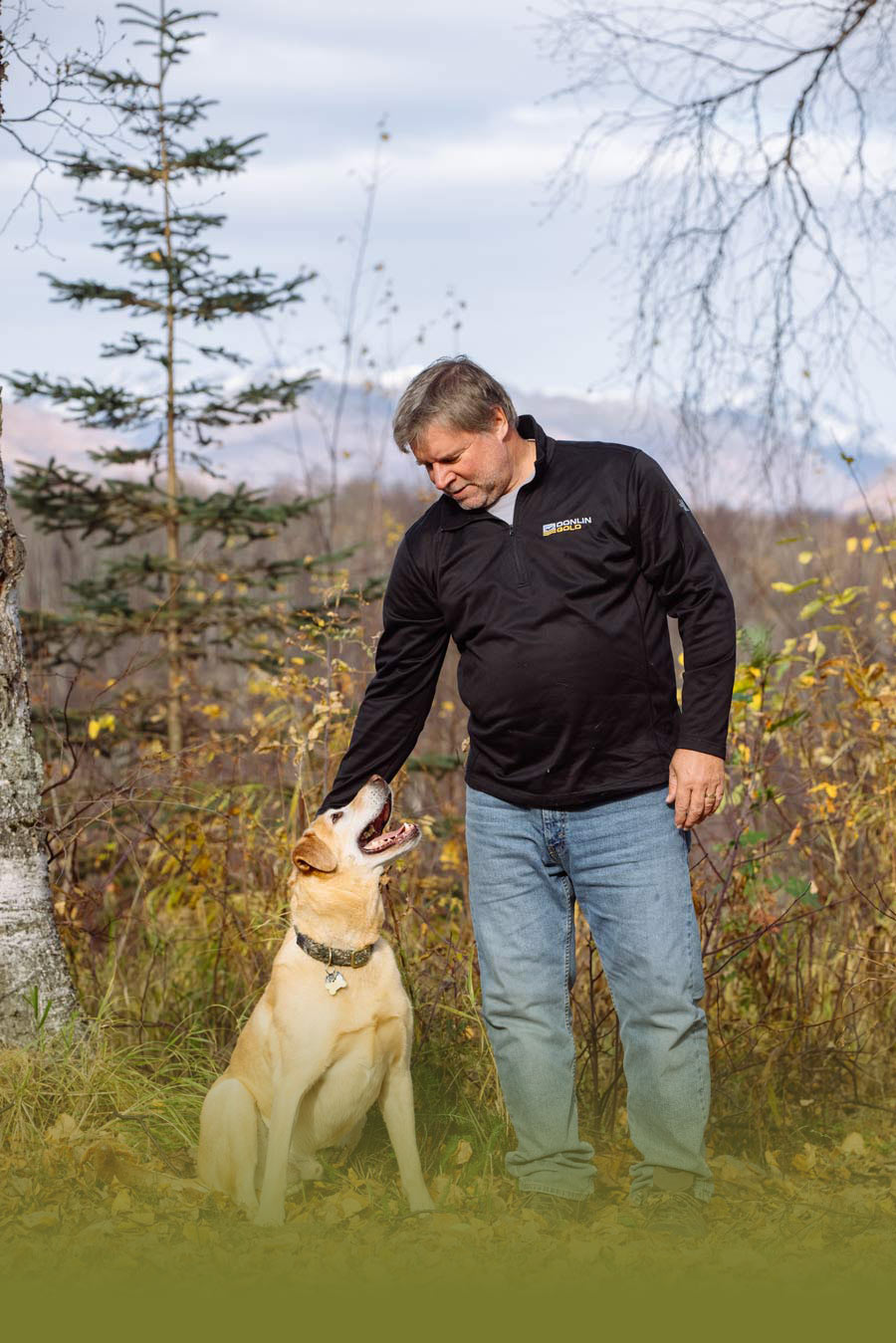
At a Glance
Ha! I have several depending on the mood I am in… I am working through the Bible, a fitness book, and a management philosophy book. There are also a few mining history books in the stack, too.
What movie do you recommend to everyone you know?
I’m not really a big movie buff.
What’s the first thing you do when you get home after a long day at work?
I like to have a seat on our deck with my wife and a beer and catch up on the day, followed by a walk with our dogs, Kilo and Milli.
If you couldn’t live in Alaska, what’s your dream locale?
I’d be torn between a small town in the mountains in the west or somewhere in walking distance to a large beach with loud surf, boogie boarding, and some snorkeling.
If you could domesticate a wild animal, what animal would it be?
A bear! How cool would it be to walk around town with a bear following you?
Off the Cuff
onlin Gold appointed Dan Graham as its new General Manager in June; he previously served as its permit manager for years. He says, “There’s nothing I would rather do than be involved in mining. As a kid I had the best sandbox equipment collection in the entire neighborhood. I spent hours digging holes and building dams. And look where I am now: same kid, just a bigger sandbox.”


